Movie Review By: SFAM
Year: 2006
Directed by: Christian Volckman
Written by: Alexandre de La Patellière, Mathieu Delaporte, et al.
IMDB Reference
Degree of Cyberpunk Visuals: Very High
Correlation to Cyberpunk Themes: Medium
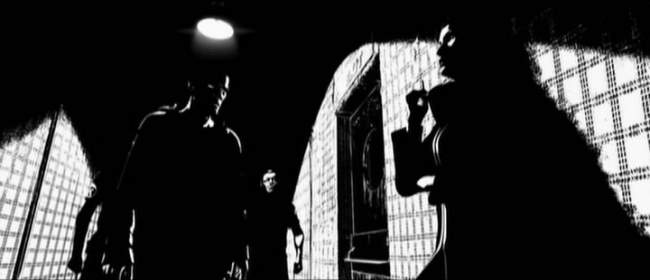
Overview – Good luck in finding a copy! Once upon a time, Renaissance was one of my most anticipated movies of 2006. Originally released in France on March 15th, I eagerly awaited its September release in the US. My anticipation was heightened in that I was even contacted by Miramax representatives as part of a pre-hype blitz. So imagine my surprise when its release in the US only comprised a few select cities – unfortunately my city didn’t make the cut (thanks Miramax!). Similar to so many other good, but foreign science fiction and fantasy flicks, instead of getting a nice theatrical viewing, I was yet again forced wait and then later buy an import (or pirated – sometimes you just aren’t sure) DVD off of eBay. If you are in the US and are interested in seeing Renaissance, chances are you’re in the same boat. One would have hoped that a movie as visually stunning as Renaissance would have been at least able to quality for a DVD release, but clearly something larger is going on here as many other foreign genre films are in the same boat.

The Setting: In the year 2054, mega-corporations are all-powerful, with tentacles in all aspects of life. The divisions between rich (megacorps) and poor are greater than ever. Paris has grown in layers, with high-tech buildings pushing every further into the sky. Although the city is sleek and stylish, most people live a pathetic existence. In Paris, the Avalon Corporation rules the cityscapes. The police force is not immune from their pressures, and often become their lackeys.
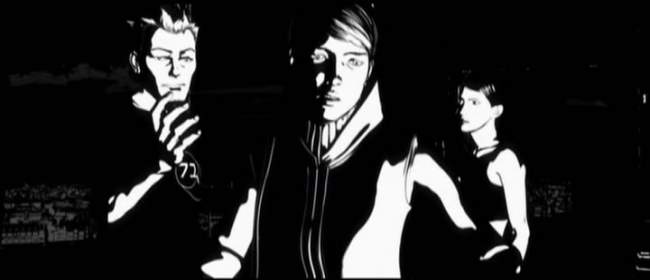
The Story: When a promising young biogeneticist named Ilona (voiced by Romala Garai) from the Avalon Corporation is kidnapped, detective Barthélémy Karas (Daniel Craig) and his team are brought in to investigate. As Karas interviews all the key players, it becomes clear that this isn’t a simple missing person case, as the details of the disappearance become increasingly more bizarre and complicated. The Avalon corporation president, Dellenback (Jonathan Pryce), not known for his loyalty to his workers, is extremely interested in her return. Ilona’s bioengineering mentor has a strange past, and stopped doing research after an accident from 2006. Karas befriends Ilona’s older sister, Bislane (Catherine McCormack), who tells of a stolen book.
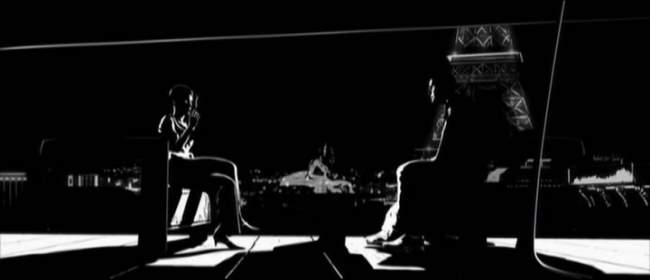
Similar to Howard Hawks’ “The Big Sleep” (1946), Karas spirals back and forth between the key players as more clues are provided. Karas uncovers a darker side of the Avalon Corporation, and of Ilona’s mentor, Dellenback. Furthermore, it appears that the secret to immortality has been discovered, and is tied to Ilona herself. As Karas and Bislane continue searching for Ilona, the list of enemies grows. The key players are getting offed, Karas is booted from the force, and is now in fear of his life. Worse, they are discovering that humanity itself may be at risk if Ilona is found.
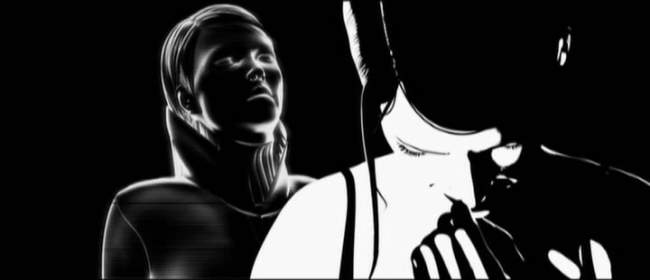
The Characters: It’s not a stretch to say that virtually every character in Renaissance comes “cookie cutter” from the old noir movies, with a nice slice of traditional cyberpunk thrown in the mix. From the honest but jaded crusty cop with a soft spot to the megalomaniac mega-corporation leader, to the shady friend the cop goes to when he needs a favor to the femme fatale; don’t expect freshness, because it isn’t coming. Like the old noirs, everyone in Renaissance is flawed; everyone is gray – which does make for an interesting contrast when transposed on such stark black and white animation.
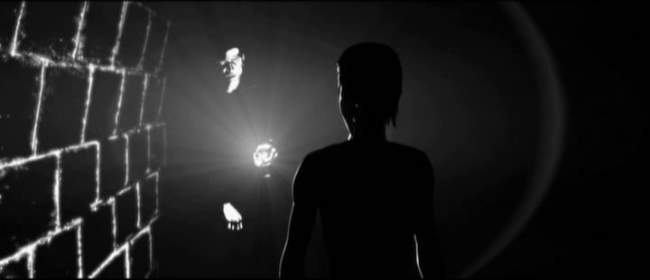
The Atmosphere: While the story falls short, the look of Renaissance fully original and is flat-out amazing. If Renaissance is best described as style over substance, the style really comes STRONG to the party. Stark black and whites dominate virtually every shot. Shadows are in abundance, and usually highlight the main action points. Gray is used sparingly, and is usually applied to change the mood of the scene. To its credit, Volckman succeeds at creating a near-future world that is deeply flawed but not overly futuristic. The cityscapes are incredibly detailed, and give the impression that there are always a bevy of interesting happenings occurring. A transparent glass-like substance is now used to make walkways above and below the roads – this more than anything creates a sleek, near-future ambience. The stark black and white look of Renaissance works well both in the daylight and evening shots, both having shadows prominently placed in virtually every frame.
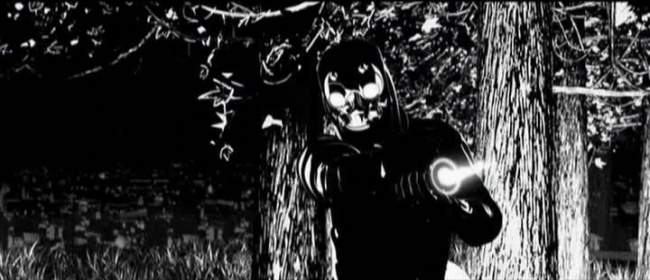
Traditional cyberpunk conventions are often applied, including huge billboards of beautiful women that extol the virtues of the Avalon Corporation. Avalon fills the role of the dominating mega-corporation that owns and controls virtually everything in Paris. Nothing is beyond their grasp. The police are on their payroll, and the entire city appears to be under surveillance. Immortality, derived through advances in bioengineering (initially undertaken by a Japanese scientist) is the dominating technology intended to challenge God’s position over humanity.
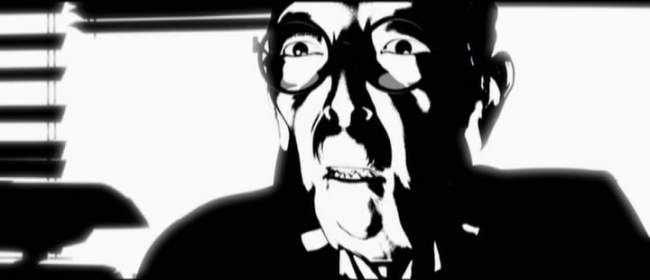
Similarities with Sin City: Volckman stated he was interested in creating a visual feel similar to what one might get when looking at a painting. In terms of what was produced, yes, the look is definitely similar, but Renaissance is not copying Sin City. Although Sin City came out first, Renaissance started its production far before Sin City. In terms of look, Renaissance really does match very closely with the Sin City graphic novels – more so than Sin City in fact. But while it also is a neo-noir, the dialogue and mood of Renaissance is far more like a corporate espionage version of a standard 40s detective noir (think “The Big Sleep” with corporations instead of the mob), whereas Sin City had more of a hyper-real, over-the-top neo-noir feel.
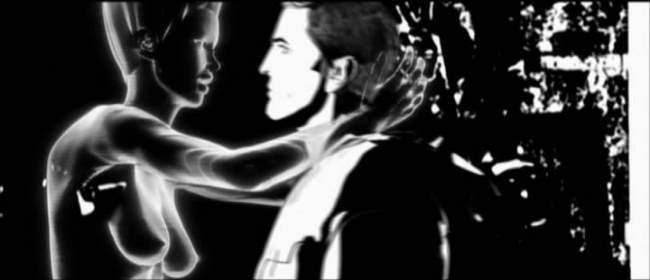
The Animation: Using an innovative motion-capture to rotoscope approach, where 24 cameras are used when shooting the actors, Volckman was able to work on the framing and viewpoint well after the shoot was complete, and then paint on the black and white animation. Unlike Linklater’s rotoscoping, where the actors’ faces and body appear to be constantly shifting, the level of precision used in Renaissance is significantly higher. When moving, the sprite’s actions are incredibly human-looking. There is a slight lag though when they first take action – a noticeable lag that’s slower than you would expect a person’s actions to be.
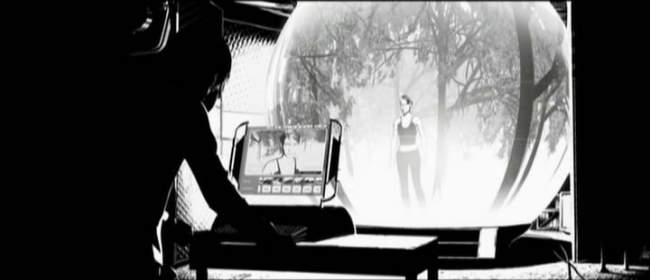
The Technology: While the basic story for Renaissance is straight cyberpunk neo-noir, the technology options provided are numerous and fairly interesting. Most visually arresting was the Holodeck sphere prison where Ilona is kept. Karas had a very advanced cybernetic eye implant that allowed him to identify people through solid objects – it also was able to be hacked by Avalon, the Mega-corporation. Computers are slick, now often just the size of a pen with a virtual display that arises upon command. Biotechnological modifications are in vogue, although not at the level of Ghost in the Shell. Similar to Motoko’s invisibility suit, the goons at Avalon have similar suits, although they look more like the soldiers in Jin-Roh than they do the hawt, naked Motoko. Holograms are now used in combination with pictures to remember people and events – in some cases, holograms interact with their human counterparts.
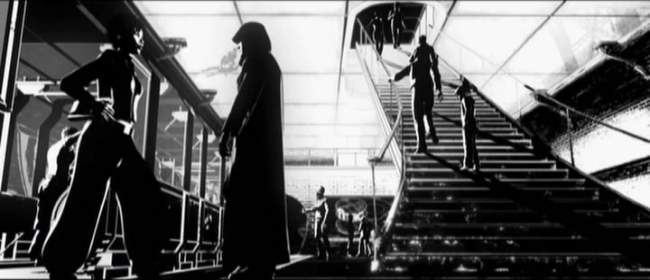
Do you Want to Live Forever? One thesis of Renaissance is the notion that immortality, if invented, would destroy humanity. Not a lot of backing is provided for this idea, but the idea put forward is that this irrevocable change in the hands of a mega-corporation would provide a method of control so powerful that society would no longer function. This is all the more interesting in that some are predicting that humanity will have the equivalent of immortality within the next 50 years. If this comes to pass, will the possibility of immortality be distributed evenly or will this be a tool of domination similar to in Renaissance?
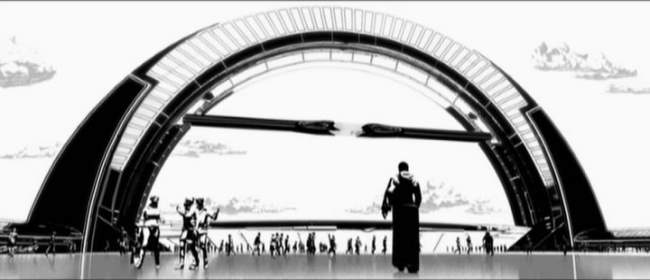
The Bottom Line: Although the story and characters are not original, the animation and overall cinematography is both innovative and outstanding, and should not be missed. There is truly something unique in the look here that you just won’t find anywhere else. The voice and motion acting are more than passable and Nicholas Dodd’s score provides a wonderful combination of a 007 espionage flick with the haunting eeriness of the score from Stargate. As icing on the cake, the science, technology and architecture exhibited in Renaissance will make you think. It may be hard to find, but it’s well worth the time spent looking for it.
Page 2, More Screencaps–>
~See movies similar to this one~
Movie Review By: SFAM
Year: 1987
Directed by: Katsuhito Akiyama, et. al.
Written by: Katsuhito Akiyama, et. al., Toshimichi Suzuki (story)
IMDB Reference
Degree of Cyberpunk Visuals: High
Correlation to Cyberpunk Themes: Medium
Key Cast Members:
Sylia Stingray (voice): Yoshiko Sakakibara
Priscilla S. Asagiri ‘Priss’ (voice): Kinuko Ômori
Linna Yamazaki (voice): Michie Tomizawa
Nene Romanova (voice)Akiko Hiramatsu: Akiko Hiramatsu
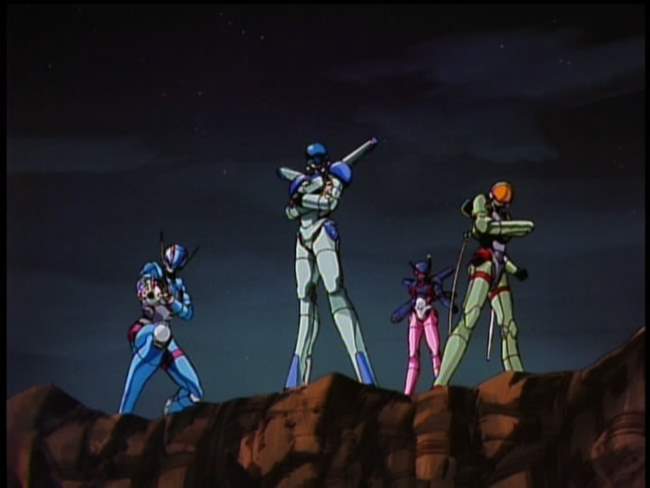
Overview: Bubblegum Crisis (BGC) is one of the all-time classics of cyberpunk animation and anime in general. With a team of hawt chicks kicking butt in cute mecha outfits, while upbeat songs play in the background, Bubblegum Crisis has developed a franchise and staying power that few titles can match. Quite a number of sequels have been created as a testament to this. BGC is influential in a number of ways. Not only has its character animation been widely imitated, BGC was one of the first shows brought over in the US with subtitles. Overall, while there are some dark moments, the original BGC is an action-oriented, mostly light-hearted affair.
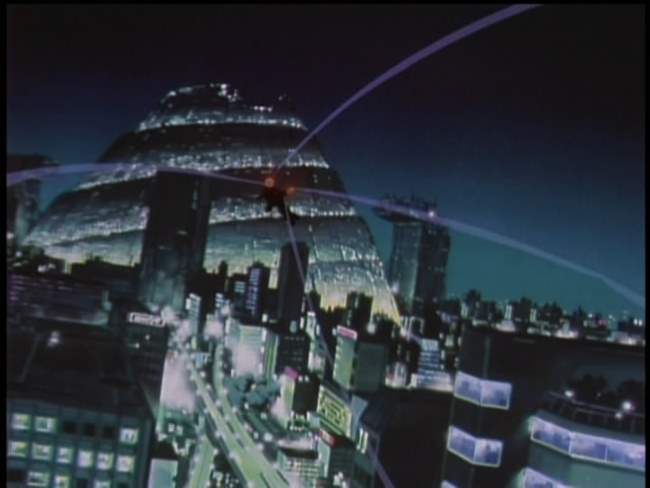
The Story: In 2025 an earthquake destroyed Tokyo. With the assistance of androids and robots created by the omnipresent and ever-powerful Genom corporation called boomers, Tokyo is rebuilt as Mega-Tokyo. Unfortunately, like Bladerunner, sometimes the boomers get out of line, often in fact. Boomers can appear human, but often this is just a fascade for a far more dangerous bio or mecha beast that can break-through the skin. In response to this danger, the authorities have created an under-funded agency called the AD Police, who’s primary mission is to handle boomer incidents. Unfortunately, often the boomers are too strong for the police to handle.
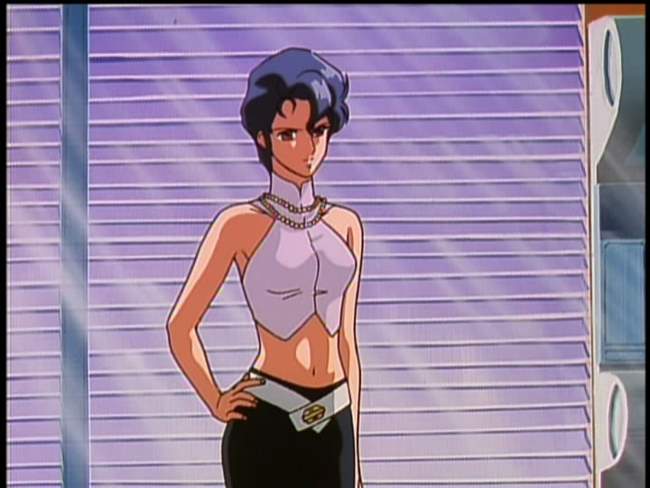
Enter the Knight Sabers. Headed up by Sylia Stingray, the billionaire daughter of the former Genom Corporation scientist who invented boomers, Sylia has advanced the research on her father’s mecha hard suits, and has recruited a team of three other hawt action chicks who, along with Sylia, comprise the Knight Sabers. All of them have secret identities. Priss is a pop singer, Nene is a hacker who works as a dispatcher at AD Police HQ, and Linna is an aerobics instructor. But all four of them have trained to become mercenaries extraordinaire in defense of boomer incidents.
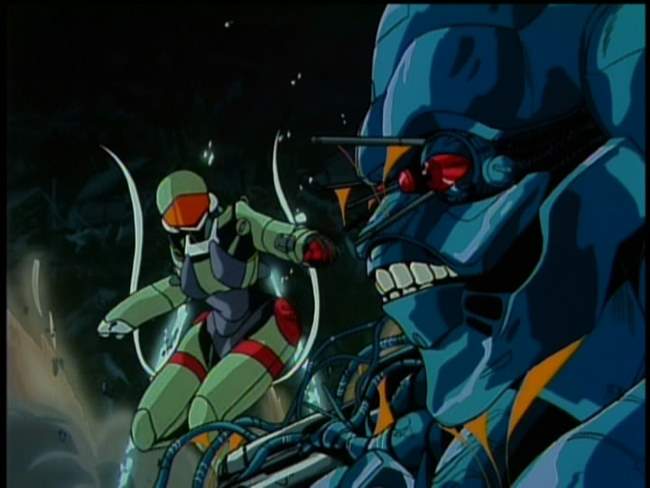
Unlike most OAVs, BGC is designed with each episode being as self-contained story. While many of the stories string together, there are no cliffhangers here. Some of the episodes have at least a modicum of intrigue, but generally, when it gets right down to it, the goal is for the knight riders to kick some boomer ass. Action dominates, which works considering the relatively short time allotted to each story (up to 50 minutes). As the series continues, most of the storylines deal with the Kight Sabers foiling attempts by the Genom corporation to secure even more power. A few of the episodes have complex storylines, but the majority are straightforward, with evil genius types (boomer or human) directing boomer machines who create death and destruction.
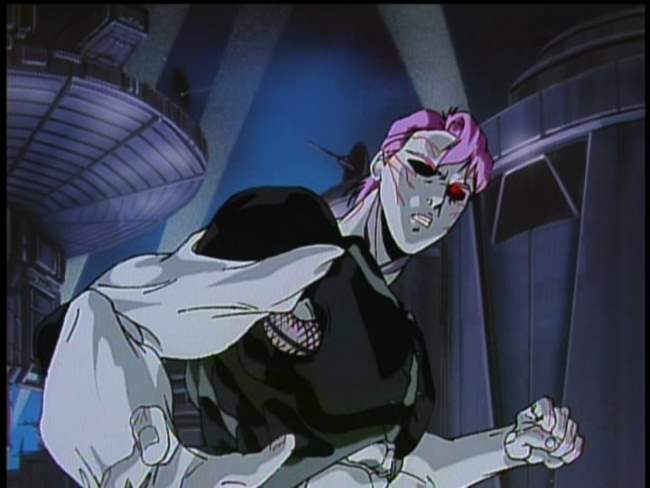
For me, my favorite episode is Episode #5, where a two unique bio-based sexroid boomers who need blood for sustenance escape from escape Genaros, the SDPC’s orbital supply station for humanity’s moonbases, and make their way to Mega-Tokyo. The episode is far more complex than most, and touches on similar issues to Blade Runner, in that these Boomers just want to be free to live. Most of the boomers in BGC (other than the major villains) don’t really exhibit any form of sentience, but the ones in this episode (and the continuation in #6) are sentient and multidimensional.
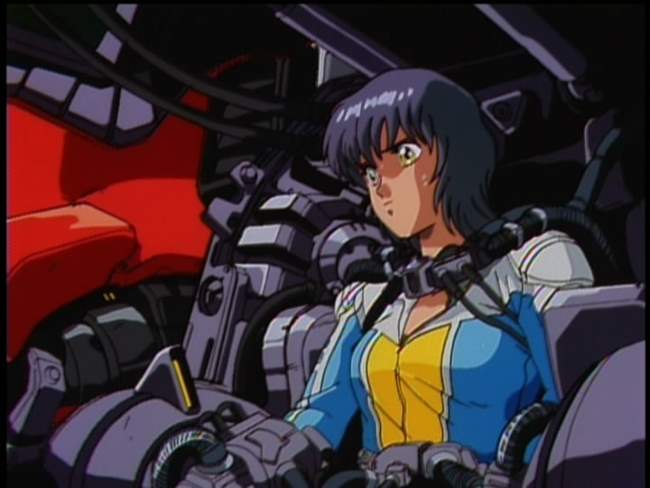
Influential Visuals: Along with Akira, BGC animation has been very influential in transforming anime to the popular style we see today. Characters with overly large eyes and the familiar facial styles are on display in BGC, as are a bevy of experimental looks and styles. The look of anime changed dramatically from the late 80s to the early nineties – BGC will always hold a place in history due to its influence on this change.
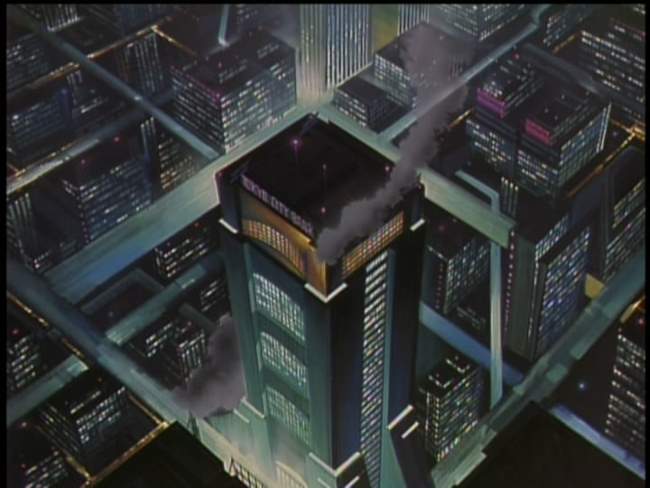
Mega-Tokyo: BGC took the Blade Runner city visuals and applied them to anime, which was then imitated by most of the shows that followed. The cityscapes are modern looking with a blue background, with various green and red highlights. Grays and blues are shown in abundance, with occasional orange and red daytime scenes. Most of the shots are from above, focusing on the overall city-scape, but there are a number of ultra-modern buildings including the Genom’s Tower (which looks like the Blade Runner Terrel Corporation building) and the AD Police building – same as Blade Runner as well.
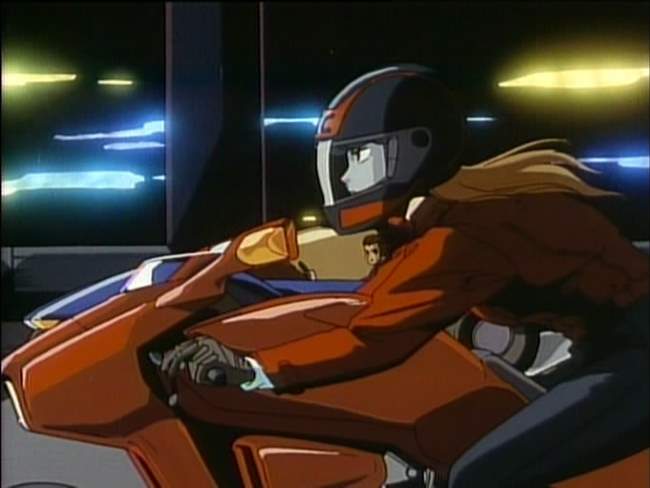
The Action: By far the best quality animation BGC brings is in their action sequences. While the rest of the series is really not very special, the action sequences are very well done. We get a variety of effects and perspectives that driving the relatively quick-pacing. In many of the scenes, the backgrounds show a variety of methods to enhance the speed and action. Often BGC engages in mecha-style battles (many of the bad-guy boomers are variations on mecha characters), but these are different from some in that the Kight Sabers are in nimble, tight-fitting suits, which increases the speed of the action.
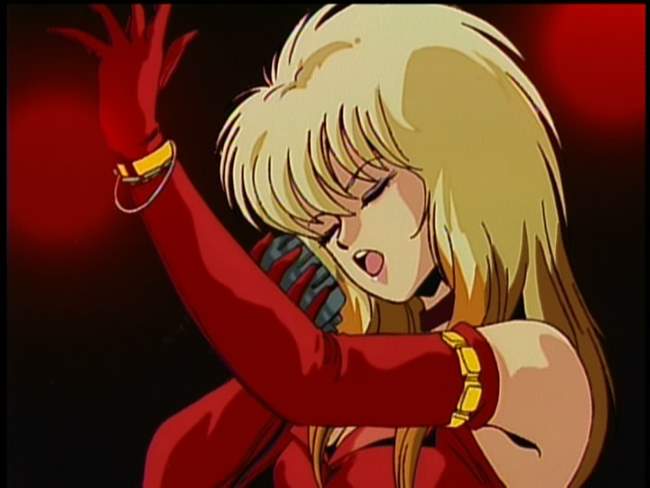
The Music: Very few OVAs have music as recognizable as BCG. BGC is known for being one of the first (or at least one of the most recognized) to essentially embed music videos into their action sequences. The songs play a big part in Bubblegum Crises, with a large number of the action sequences and dramatic moments overlaid with song accompaniment. Almost twenty years later, this innovation has blossomed and morphed into what we see with FLCL for instance, where entire sequences are purely videos intertwined with the story.
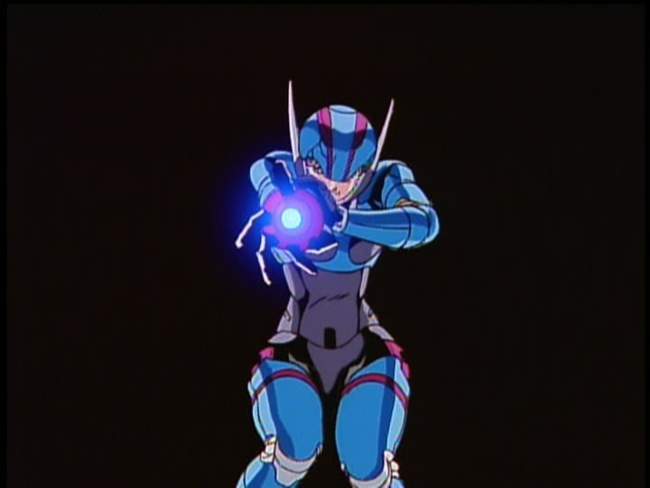
The Bottom Line : While I’m generally not too excited about mecha anime (this is purely a preference on my part, and not a knock on mecha), I find BGC quite enjoyable. BGC is more like an earlier version of GITS SAC in that the focus is action first, and philosophy second. While a few episodes do explore what it means to be human, in all but a few cases, this is usually done in the context of a fairly light plot and intense action. Perhaps the philosophical aspects would have been highlighted had the series continued, but for legal reasons, BGC was cut short at only eight episodes. On pure enjoyment I’d probably rate the series a 7 out of 10, but due to its significant influence on anime and cyberpunk I’m giving it an extra star.
Page 2: More Screencaps —>
~See movies similar to this one~
Movie Review By: SFAM
Year: 2006
Directed by: Richard Linklater
Written by: Philip K. Dick (Novel) Richard Linklater (Screenplay)
IMDB Reference
Degree of Cyberpunk Visuals: Medium
Correlation to Cyberpunk Themes: Medium
Key Cast Members:
Bob Arctor: Keanu Reeves
James Barris: Robert Downey Jr.
Donna Hawthorne: Winona Ryder
Ernie Luckman: Woody Harrelson
Charles Freck: Rory Cochrane
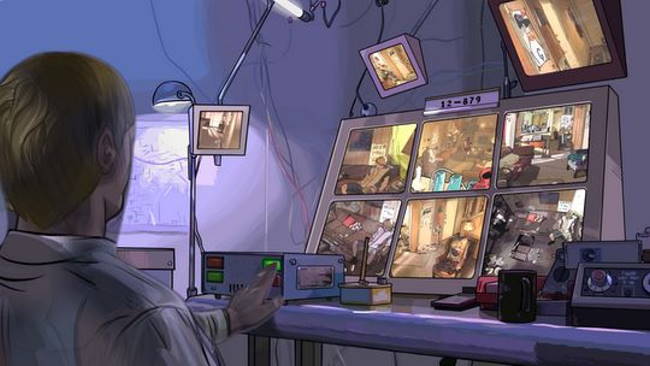
Overview: In a very faithful adaptation to Philip K. Dick’s story of the same name, Linklater treats us to an interesting, slow moving story about abuse – abuse of power, drug abuse, abuse fo friendships, and abuse of the self. While most of the publicity about Scanner Darkly is about the rotoscoping technique used, the story itself is good enough that it probably could have worked in live action as well. A Scanner Darkly is engaged in a slow-opening process – hopefully you all get to see soon in a theater near you.
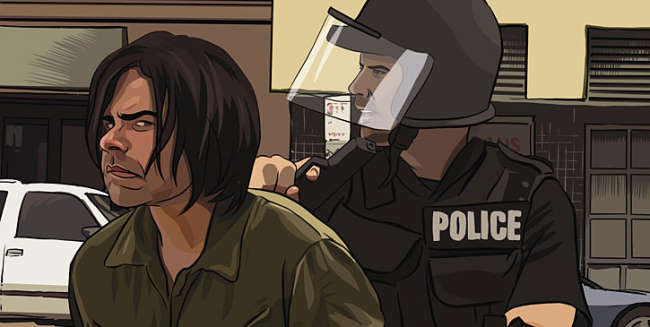
The Setting: Seven years into the future, a drug known as Substance “D” has transformed society. People are divided into addicts and those who haven’t taken Substance “D.” Society is quickly collapsing. In response to this threat, the government has transformed the society into a surveillance state, where neighbors spy on neighbors, and personal freedoms have been minimized. Everything is organized for instant observation – license plates are now bar-coded, and security is all DNA based. Trust has all but vanished in the world where Scanner Darkly resides. In its place, we have people who are constantly concerned about each other’s ulterior motives, and think nothing of stabbing someone in the back if only to win short term gains.
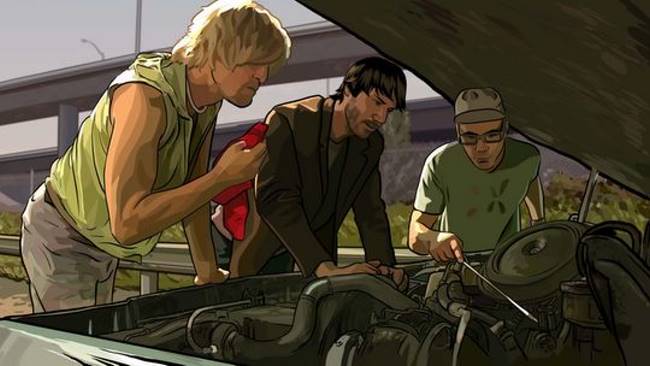
The Story: Scanner Darkly takes place seven years into the future and follows the plight of a close-knit group of addicts living outside of Anaheim, California. Bob Arctor (Keanu Reeves) is works as a reluctant undercover police officer (called “Officer Fred” at work), who lives with group of addicts that he eventually needs to perform surveillance on. Bob no longer believes in what he is doing, but still goes through the motions. At work, all the police wear “scrambler suits” to ensure nobody knows who they are. As the story progresses, we get to see the absurd lives that each of the addicts lead. Bob’s girlfriend (Winona Ryder) is a coke addict who freaks out if touched; his friend Charles (Rory Cochrane) sees insects crawling over him at all times, and his two room mates are clearly fried beyond all recognition.
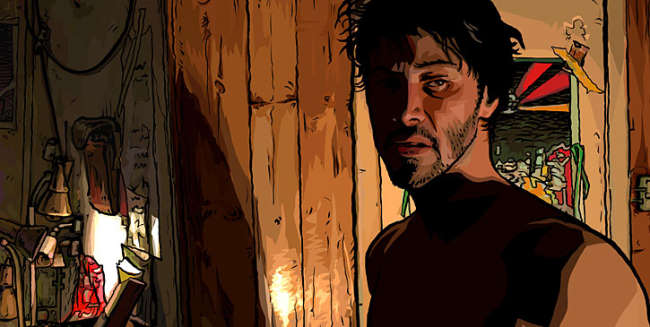
Unfortunately for Bob, his addiction is growing too. His grasp on reality starts to weaken as the hallucinations increase. He starts seeing his room mates as huge insects. Worse, one of his room mates (Robert Downey Jr.) visits the police department to narc on Bob. Bob, as the disguised Officer Fred, has the task of taking down his room mate’s statements and investigating them. As the movie proceeds, Bob becomes more disillusioned with his job and life, and begins to realize that he is losing his humanity.
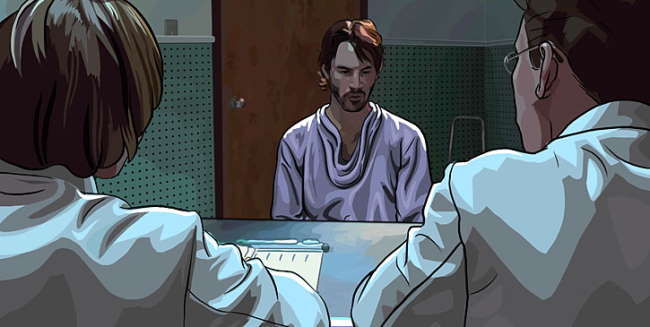
An Excersize in Duality: Scanner Darkly sets a number of issues up in a duality. We have left brain – right brain separation as a side effect from extreme exposure to Substance “D,” we get surveillance and security opposing personal freedoms, and the two doctors treating Bob overtly represent the left and right hemispheres. Everything in Scanner Darkly is about dualities of tension, and the descent of humanity in the face of this tension.
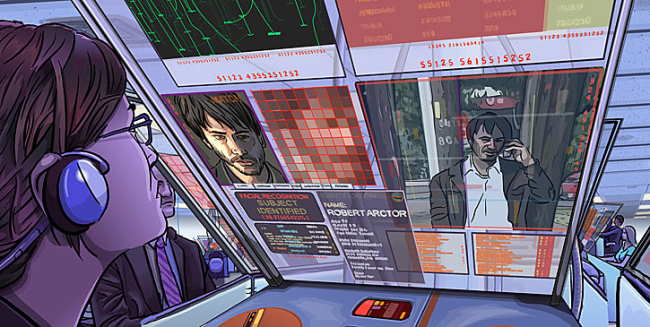
The Paranoia: A Scanner Darkly delves into the paranoia mindset that develops when drug use combined with an out of control surveillance society has taken hold. Personal rights and individual freedoms are significantly subordinated in a society where the government is after the supposed drug barons. One begins to question, however, whether the drug barons themselves are just yet another tool by the government to gain complete control over the population. The idea of government abuse of power permeates virtually every scene. The ranting sessions within the drug addict group are all based on paranoid delusions about what the government is currently doing to them. Worse, some of their “paranoid delusions” end up being true!
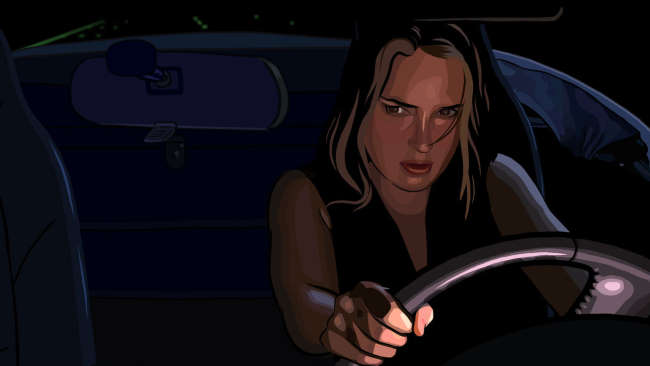
Drugs Are Bad, K? Scanner Darkly pounds this message in as many ways as possible. Wanna screw up your perception? Substance “D” is for you! But don’t worry, its effects are not always permanent, just most of the time! Within the addict group, we see different people in various states of insanity. The message is clear – once you’re on this stuff, the descent into insanity is all but assured.
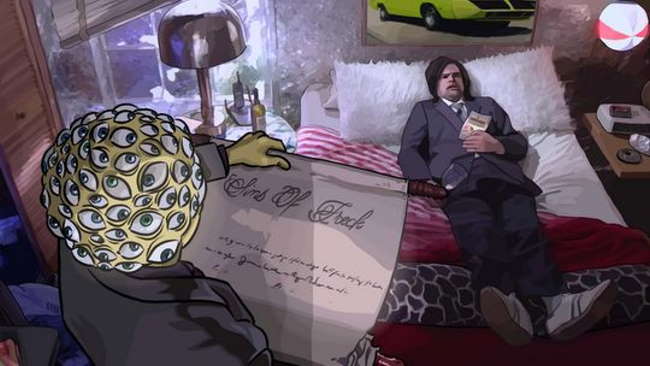
The Rotoscoping: The rotoscoping in Scanner Darkly works well as a device to create an atmospheric, otherworldly film, even though most of the scenes almost came off as red-neck central. Unlike Waking Life, where the hand drawn animation on top of live action is wildly uneven (on purpose) with the characters, for the most part the rotoscoping just gives it an ambiance. Also, the rotoscoping provides a wonderful base for the various hallucinations that happen in the course of the movie. Linklater’s rotoscoping technique seems to work best when there isn’t that much action on-screen. In some of the movement scenes (car riding, running, etc.), there is almost no difference between the rotoscoping and live action. There was also a lot of variances with the black lines around the faces – mostly this was pretty subdued, but in a few scenes, the black lines almost dominated the scene.
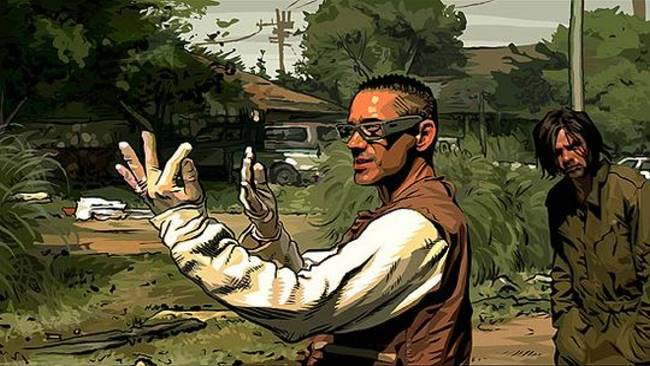
The Acting: For the most part, the acting is terrific in Scanner Darkly. Robert Downey Jr. especially shines, but Reeves’ performance fits perfectly for a man overtaken by events. Winona Ryder has some pretty solid moments (especially at the end), as does Woody Harrelson and Rory Cochrane. The better scenes usually involve Downey and another character involved in truly bizarre conversations. Some with Downey and Harrelson in particular are pretty funny.
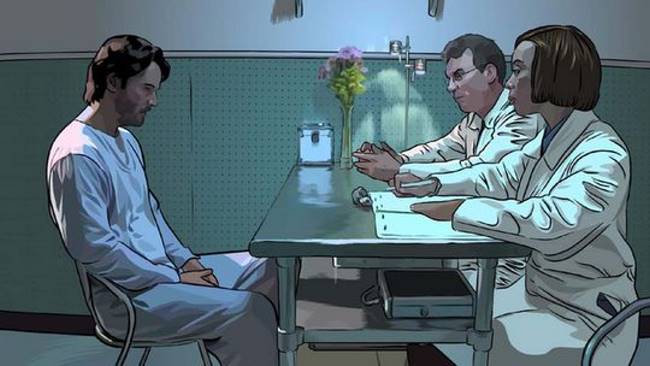
The Bottom Line: A Scanner Darkly is a movie with great acting, interesting discussions and a very powerful ending. That said, some parts of Scanner Darkly come off as overkill (the drugs are bad part, for instance), whereas others could easily have benefited from more elaboration. Still, these are minor complaints, as the overall movie has terrific acting, a great score (by Radiohead), and an interesting, well constructed message. Fair warning though - this is NOT an action movie. The vast bulk involves people milling around and talking, without any real action ever taking place. As long as action isn’t necessary for you to enjoy a good cyberpunk flick, give Scanner Darkly a try.
~See movies similar to this one~
Movie Review By: SFAM
Year: 2002
Directed by: Kenji Kamiyama
Written by: Masamune Shirow (Story), Kenji Kamiyama (Chief Writer), et al.
IMDB Reference
Degree of Cyberpunk Visuals: High
Correlation to Cyberpunk Themes: Very High
Key Cast Members:
- Major Motoko Kusanagi: Atsuko Tanaka (Japanese), Mary McGlynn (English)
- Batou: Akio Otsuka (Japanese), Richard Epcar (English)
- Chief Daisuke Aramaki: Osamu Saka (Japanese), William Knight (English)
- Ishikawa: Yutaka Nakano (Japanese), Michael McCarty (English)
Rating: 9 out of 10
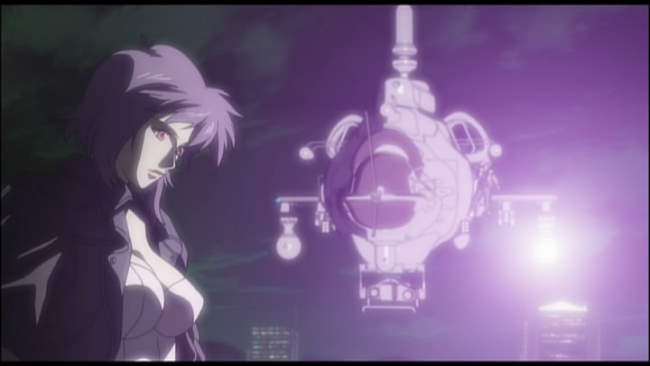
Overview: Ghost in the Shell Stand Alone Complex (GITS SAC) uses the same characters as Masume Shirow and Mamoru Oshii, but takes place prior to the first GITS movie. Like the GITS movies, GITS SAC revolves around Section 9, an elite anti-terror police force that works behind the scenes to keep the peace. The overall tenor of this series is far more action oriented than Oshii’s movies. While there are a few philosophy moments (including a terrific one with Batou and the Tachikomas), the vast majority of the season is action oriented. In short, we get high-end, slick cyberpunk butt-kicking in GITS SAC – one that’s well worth watching, even if you do miss the philosophy.
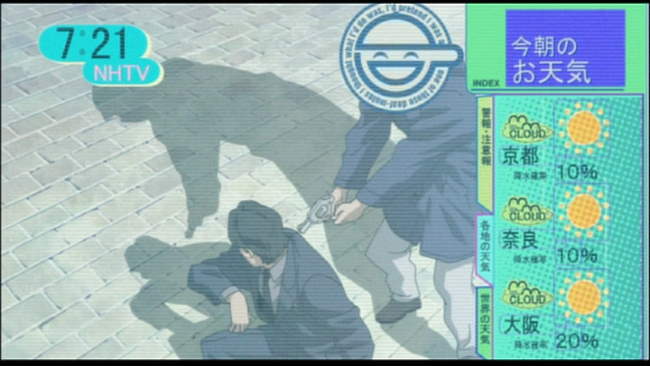
The Laughing Man Story: In a world where cyberization has become the norm for a large segment of the population, a number of negative side effects have become possible. In addition to cyberbrain hacking, a disease called Cyberbrain Sclerosis has emerged which seems to randomly affect many who’ve undergone significant cyberization. The Mega-corporation, Serano Genomics has produced a cure for Cyberbrain Sclerosis – Serano Micromachines, a nanotech implant device that, when ingested regularly supposedly halts and eventually works to cure the disease. Unfortunately, the Micromachines only seem to help a small segment of those contracting the disease. A hacker named the Laughing Man seems bent on exposing a cover-up – one which posits that the lost Murai Vaccine has an almost permanent curative for those with Cyberbrain Sclerosis. Unfortunately for Serano Genomics, a real cure for Cyberbrain Sclerosis would decimate their profitability.
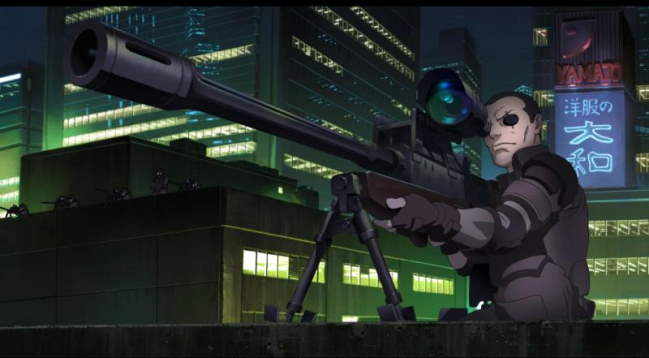
The Laughing Man is a hacker extraordinaire who is able to hack into cyberbrains at will, and worse for public confidence, is able to take over TV shows at will. Section 9 has been brought in to find and stop the terrorist known as the Laughing Man. Throughout the season, while there are side plots, it’s the Laughing Man story which drives Section 9. As it continues, the intrigue builds and the plot thickens. Eventually, corporate betrayal, political scandals and personal vendettas play a role in setting the context and exposing the larger truth.
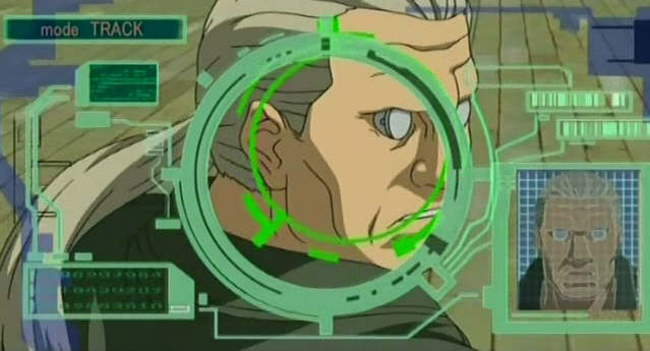
The Side Stories: While the Laughing Man is the focus of the season, there are many side quests in GITS SAC. Some of the episodes closely resemble stories from Masume Shirow’s original GITS Graphic Novel. Among these, Batou has an interesting commando encounter with his past, and Aramaki is taken prisoner by thieves in a bank, only to get involved in a more intriguing plot. For him to survive, Motoko must be able to interpret his actions from afar to correctly figure out his strategy. Generally, the stand-alone episodes are good enough to keep you entertained – some are excellent.
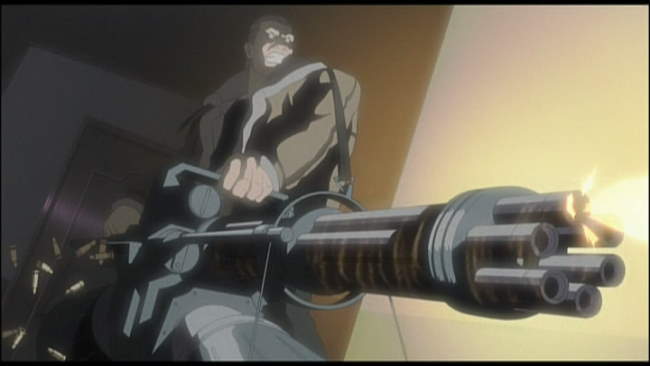
7Th Volume is the Best: While GITS SAC is pretty good throughout the series, the 7th volume – the last one – is by far the best. Without the 7th volume, I would probably rate GITS SAC 8 stars, but the 7th volume really deserves a 10 star rating. In the 7th volume, Section 9 is disbanded, while political intrigue hounds their very lives. The team escapes a crack commando unit and then all go their separate ways. Motoko and Batou become the focus of the volume, and in doing so, display more humanity and feeling then they do the rest of the series. On top of this, many of the best FX are found in volume 7.
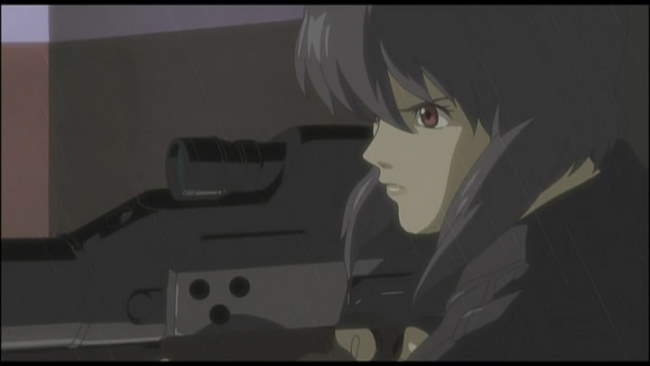
Differences with Oshii and Similarities with Shirow: Whereas Mamoru Oshii’s movies centered on the impacts of a cyberpunked society to the individual (Motoko in GITS, and Batou in GITS: Innocence), GITS SAC tends to broaden the filter to look at overall patterns in society. This leads to wonderful throw-away gems like the virtual meeting room (basically a holodeck) where everyone jacks into the meeting and then disappears when complete. We also get plots centering on problems with children in this changed new society, alienation of the masses, and loss of identity and humanity as technology takes center stage in human interaction. GITS SAC is also far more like Masume Shirow’s original graphic novel. While it doesn’t have the overt sexuality of Shirow’s work, Motoko is drawn as Shirow would; Shirow’s humor is evident in a number of the episodes; and the action takes center stage for the most part.
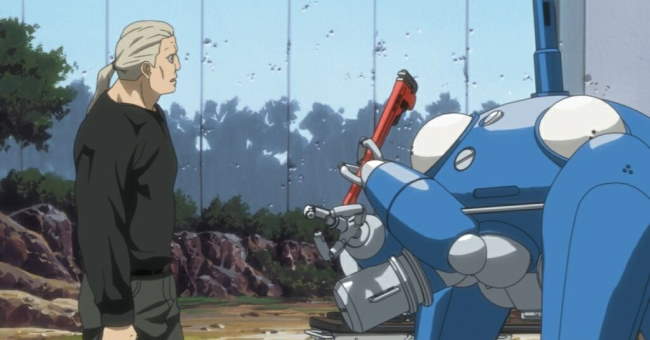
The Tachikomas: Early on, Major Motoko Kusanagi determined that the Tachikomas weren’t destined to be front-line fighting droids. For this reason, in order to become useful, the Tachikomas sped up their learning AI processing. As the season progresses, the Tachikomas begin to exhibit full signs of sentience, including Freewill and more devious functioning – so much so that Motoko becomes worried about their potential. Many interesting discussions take place over the development of the Tachikomas. One of the more intriguing ones that wasn’t really answered was whether being a digital life form instead of an analog one, would the Tachikomas ever develop a Ghost?
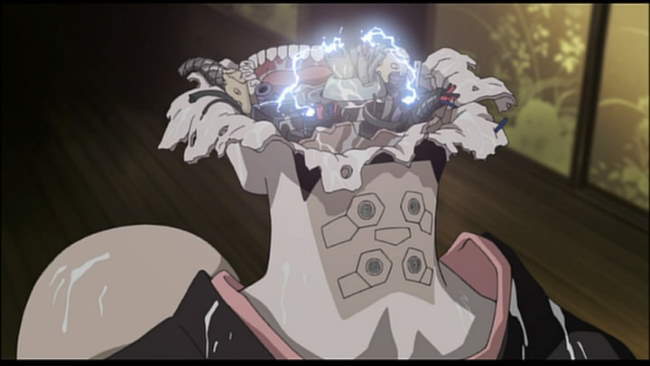
External Memory Devices and Cyberbrains – Augmented Thinking: One of the really interesting things about the GITS world is the integration of augmented brains. Conversations and complex thinking become dramatically enhanced. While the philosophical conversations are significantly reduced in GITS SAC when compared to the GITS movies, we still get a myriad of instances where cyberbrains allow people to call up a set of details about any subject that no other human could ever do. Cyberbrains in GITS SAC show a society where humanity truly has become post-human in a very real way, even though the actual look of most humans hasn’t changed much.
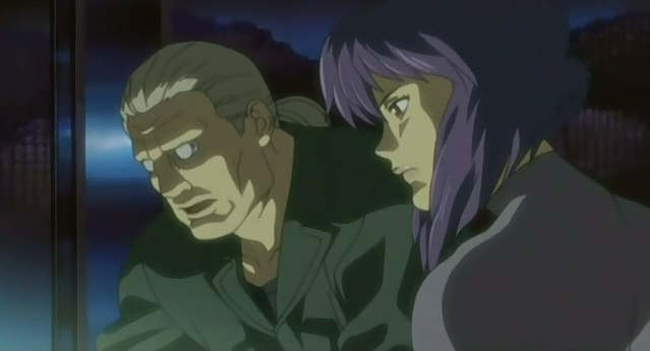
The Dubbing: GITS SAC is one of the few animes where the English cast is just about as good as the Japanese cast. Both William Knight (Aramaki) and Richard Epcar have been in their roles from the initial Ghost in the Shell movie in 1995, and all of the cast members have stayed consisted for both GITS Innocence and GITS SAC. Atsuko Tanaka (Motoko), Akio Ôtsuka (Batou), and Kôichi Yamadera (Togusa) have also been in their roles since 1995. It’s hard to pass up on Atsuko Tanaka though – I love her as Motoko. In any event, while the moods between the English and Japanese cast are different, they are both excellent.
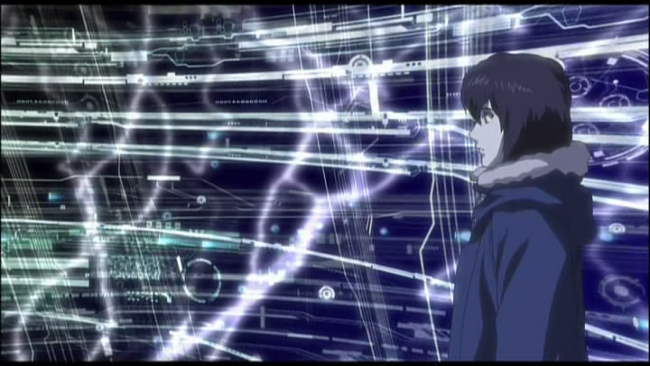
The Sound: GITS SAC consistently has decent quality sound supporting the visuals. The use of the side speakers for voices is especially emphasized. The sound FX (explosions, gun shots, car chases) are always top notch. But truly, the most impressive thing in terms of sound is the sound track. The opening and closing songs (Inner Universe and Lithium Flower) by Yoko Kanno are flat out terrific. Throughout, we are treated to a variety of songs and background music, which almost always add to the action and visuals on screen.
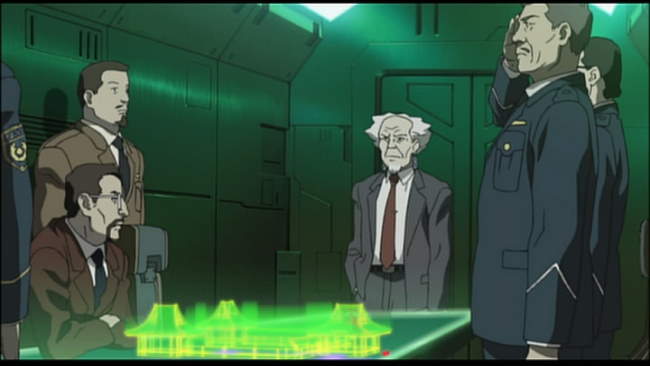
The Visuals: GITS SAC has a variety of aids that add to the overall quality of the look. While some shots look pretty basic, others involve a variety of cool FX, including digital color grading, a myriad of environmental effects, and cell-shaded computer models. GITS SAC gives us a variety of color palettes including dominant greens, reds and blacks, and occasional blues and yellows. Overall, GITS SAC is a very professional, high quality production.
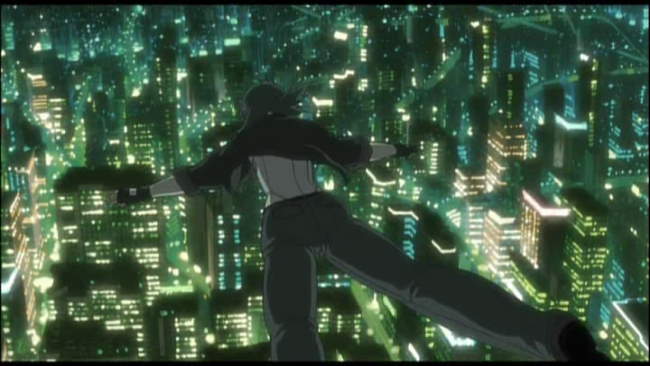
The Bottom Line: GITS SAC is a high quality cyberpunk production. While I personally like the tone and tenor of Oshii’s movies far more than I do GITS SAC, this is a personal preference. GITS SAC provides continued quality action wrapped up in impressive visuals and sound. While the first 6 volumes might only merit an 8 star rating, the conclusion is just terrific. This, along with the overall high level crafting GITS SAC provides throughout (visuals, sound, dubbing, songs) certainly raises the bar. And do yourself a favor – watch GITS SAC on a system with high quality surround sound – you’ll notice the difference.
Movie Review By: SFAM
Year: 2005
Directed by: Ben Steele
Written by: Darren Dugan, John Pinckney, & Ben Steele
IMDB Reference
Degree of Cyberpunk Visuals: Very High
Correlation to Cyberpunk Themes: Very High
Key Cast Members:
Leda Nea: Xi
Goho, Mary Nea: Molly Pinckney
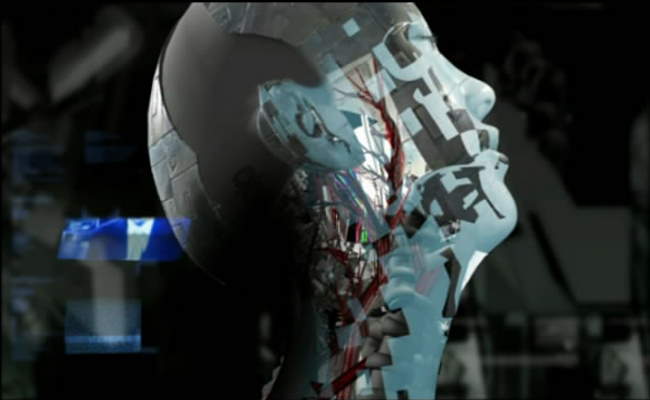
Fragile Machine - a Cyberpunk Operetta: If there was ever such a thing as a cyberpunk operetta, Fragile Machine is it. Fragile Machine is an indie anime film short created by a very small organization of talented artists called Aoineko. Fragile Machine’s narrative is largely told through haunting Chinese and English vocals set to a rhythmic, keyboard-laden techno beat (you can hear the main track by clicking on the aoineko link above). The combination of mind-expanding surreal android images with Aoineko’s music provides an intensely immersive experience – one which slowly envelopes your senses until you are a participant on Leda Nea’s journey. Fragile Machine is divided into six distinct chapters, and is narrated by a small android girl named Goho.
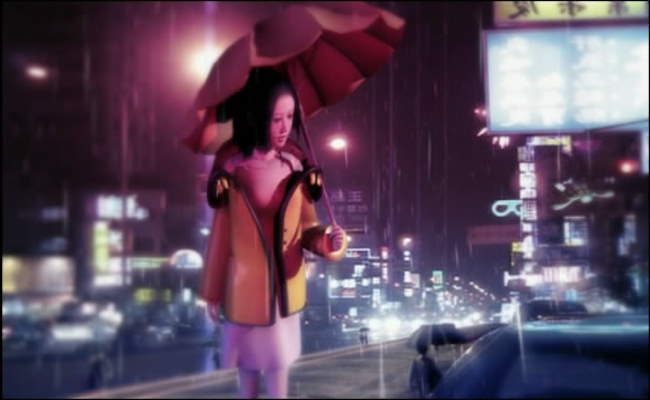
The Story: Leda Nea, a lead scientist heading up android firm, Göln Remedios’ Project Zero, is distraught over the death of her daughter, Mary. She no longer is interested in living, and decides to sign away her rights to be become a test subject for Project Zero. Leda Nea agrees to have her consciousness inserted into an android body, but the experiment goes horribly wrong, and Nea’s consciousness is permanently trapped in the android. A year goes by and Leda Nea becomes Göln Remedios’ primary work. Leda Nea has lost all sense of her former life, but still realizes she is trapped in a antiseptic prison – one which she desperately wants to escape.
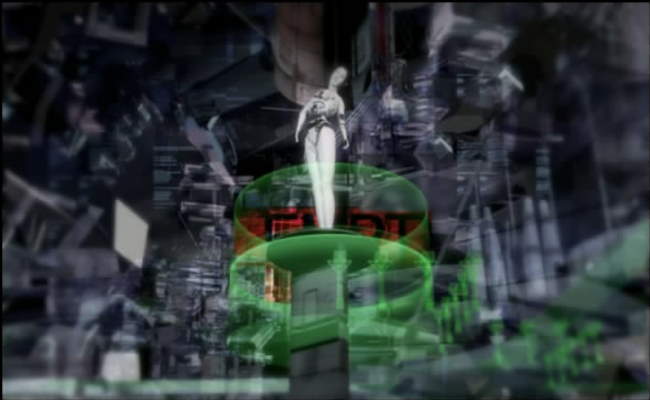
Eventually Leda Nea finds a way to trick her captors by using some of the android shells as decoys. Allthough still pursued by Göln Remedios’ droids, she escapes to the woods, and, surrounded by nature, begins to remember her humanity. In doing so, Leda Nea remembers that she hates herself and her very existence, and finally begins to remember the daughter she has lost. She continues to be pursued by Göln Remedios’ drones, but instead of getting captured she throws herself into a lake, and thus destroys her android body. At this point, her soul frees itself from its android host and embarks on an entirely new journey – one which could potentially provide Leda Nea salvation by connecting her back with that which she lost. While the ending chapter is visually astounding, I can’t go further without giving away the rest of the story.

A Post-modern Narrative: One one level, Fragile Machine appears to be a straightforward narrative in that it is explicitly divided into six chapters. Yet in watching this film, it becomes clear that the narrative is anything but straightforward. To understand the story, the viewer must pay close attention to the symbols, lyrics Goho’s commentaries, and the various visual indicators sprinkled throughout the film. While lasting just over 30 minutes, those interested in understanding the message will definitely benefit from giving Fragile Machine multiple viewings. The third time through, I found myself freezing the screen on a number of images in order to understand their significance. The story summary above is the result of watching Fragile Machine a number of times prior to piecing this all together. For instance, only very late in the film do you find out that Leda Nea is project manager of Project Zero, and is thus, responsible for her own destruction.
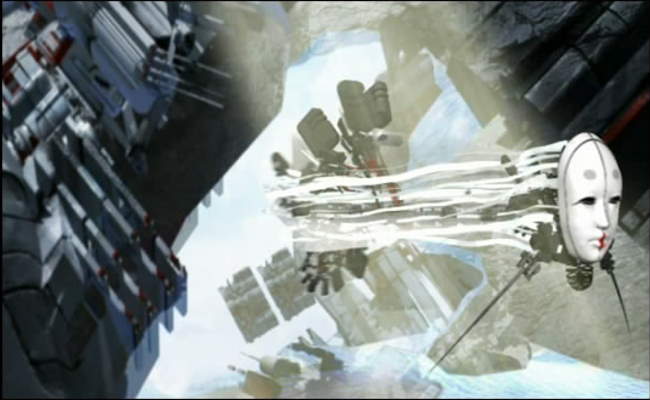
The Visuals: Even if you don’t care to spend time understanding the rich story and symbolism, Fragile Machine’s android visuals alone are well worth the cost of the DVD. Fragile Machine comes at man-machine integration and android creation and destruction from such a myriad of directions that it leaves the viewer in a state of wonderment. Through the film, color palettes are linked with the various symbols portrayed in Fragile Machine. Visual Homages are paid to a myriad of sources including Blade Runner, Metropolis, Ghost in the Shell and Planet of the Apes.

Animation Issues: While the artwork in Fragile Machine is intensely creative, the CG movement is definitely subpar when compared to some of the larger budget works. When Leda Nea is running, or the puppet narrator, Goho, is talking, the quality of the animation negatively affects the immersion. Depending on how you come to see Fragile Machine, this might be enough to turn you away from this incredible picture (perhaps this accounts for the insanely low score on IMDB). However, I would argue that the animation is only a minor knock in an otherwise perfect film short. In looking at the immensely small crew involved in making Fragile Machine, they pretty much nailed all aspects of this film that didn’t require massive CG animation engines. The post-modern story, the artwork and the music are all par excellence.
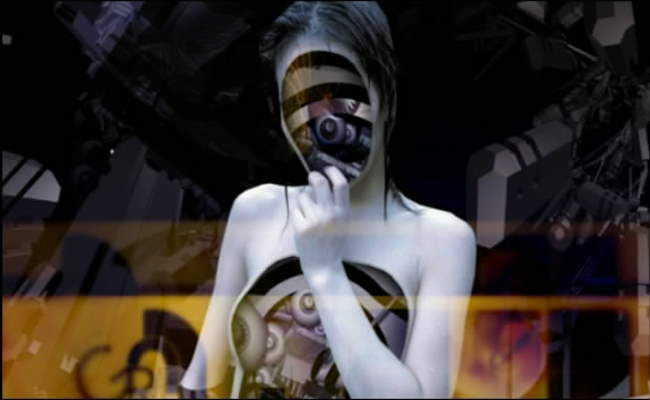
Interpreting Fragile Machine: Fragile Machine is visually and symbolically rich enough that the viewer can extract a number of fascinating thoughts. However, the larger point that Fragile Machine traces is a common cyberpunk theme - the idea that humans, in its pursuit of technology believes they will become omnipotent, with power over life and death itself. Yet in pursuing this course, we end up losing that which defines us – our humanity. Eventually, this pursuit of the taboo ends up destroying our very society. In a wonderful review of Fragile Machine, Jens points out that the corporation developing the androids, Göln Remedios, is visually similar to the Tower of Babel – both are stretching to the heavens in order to become God’s equal.
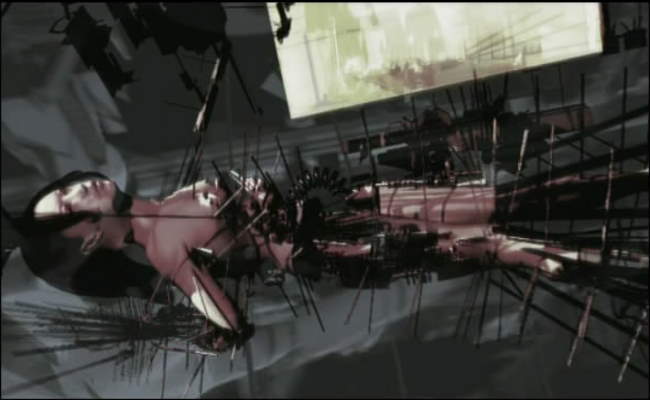
When we find out that Leda Nea is in fact the Lead for Project Zero, the emphathy shifts from a rather simplistic view Göln Remedios’ evil CEO figure being responsible to a far richer view. Leda Nea, in losing her daughter has lost her humanity, and thus no longer feels compelled to remain “human.” Her decent into subverting humanity starts well before she is captured in an android body. It begins with her work to build project zero – a project which at it core attempts to extract humanity and incarcerate it within a machine host. One almost wonders if Leda Nea initiated Project Zero in response to her daughter’s death. While the evil CEO is clearly interested in using Leda Nea as a tool in attaining virtual Godhood, it is Leda Nea who chooses to become the virtual fallen angel (as depicted by her red hue much of the time during her android descent). But ultimately, Fragile Machine becomes a story of redemption, as Leda Nea’s lost daughter, as represented by the elephant doll, becomes her guide towards finding ultimate salvation.
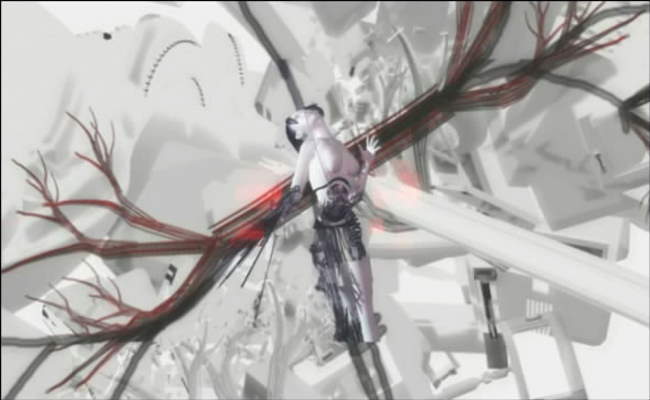
If an Android had a soul, what would happen to it when it dies? One of the more interesting questions Fragile Machine raises is the idea that if an android had a soul, what would happen when it dies? In pursuing this thought, Fragile Machine operates in the same territory as Ghost in the Shell, in which a human soul is essentially trapped within an android body. But the thought it raises can easily be taken farther than this: as we move ever closer towards sentient machines, what exactly becomes the difference between machines and humans? If machines become sentient, could they not also develop a soul? And if so, can this soul exist in some fashion even after its host has died?
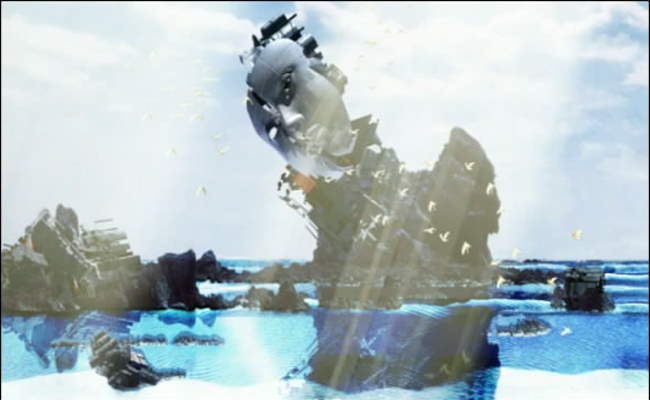
What Does a Human Mask Represent? Similar to f8, Fragile Machine uses a mask of a human-looking face to represent the attainment of humanity. Only in this case, the mask represents humanity’s technology enabled drive to create post-humanity – androids in our own image. Interestingly, this interpretation masks when viewing the last chapter of Fragile Machine leads to an interesting conclusion about the pursuit of post-humans. One wonders whether it is possible to pursue sentient androids in a way that does not explicitly challenge God’s (or nature’s) sacred role over life and death. Fragile Machine almost seems to be advocating an evolutionary, emergent approach over an overt, dominating, dehumanizing approach.
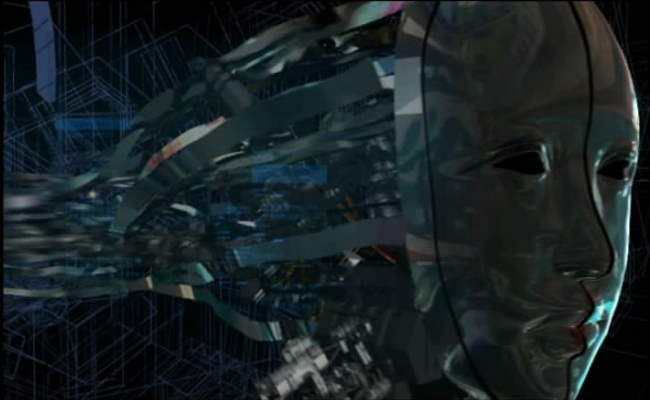
The Bottom Line: Rarely do we encounter a film so creative in its development, where the sounds and visuals are inexorably linked in expressing such an interesting story. While the animation isn’t on par with larger scale productions, the songs and visuals more than make up for it. In totality, Fragile Machine conveys a complex, multi-layered story that is rich in symbols and ideas. This is truly a piece of cyberpunk art not to be missed. The DVD was out of print but is available again (see in the comments section for details). Give it a try if you’re looking for something different.
Spoiler Alert! Page 2 has more screencaps, but some relate to the ending –>>
~See movies similar to this one~
Movie Review By: SFAM
Year: 2002
Directed by: Kazuto Nakazawa & Naoyuki Yoshinaga
Written by: Chiaki Konaka
IMDB Reference
Degree of Cyberpunk Visuals: High
Correlation to Cyberpunk Themes: Medium
Key Cast Members:
Basil: Kazuhiko Inoue
Reiko Michaelson: Akemi Okamura
Rod Kimball: Somei Uchida
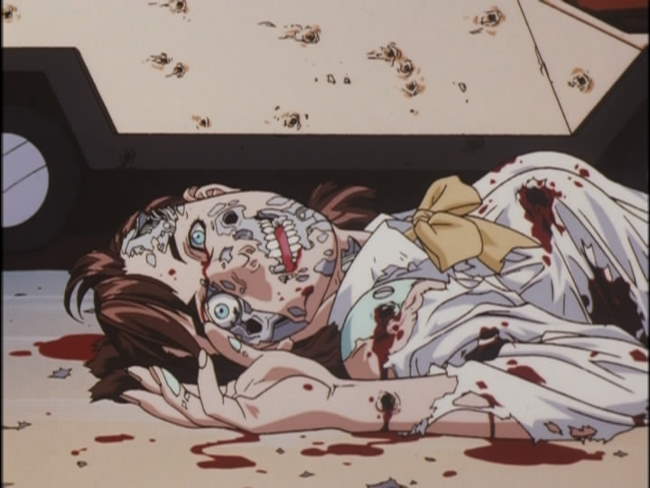
Overview: Parasite Dolls, another cyberpunk anime written by the prolific cyberpunk anime master, Chiaki Konaka (Serial Experiments Lain, Texhnolyze, Armitage III, Malice@Doll, and Bubblegum Crisis 2040), is a visually interesting, VERY adult OVA from the Bubblegum Crisis universe. The androids (called boomers) in this show are fully android (at least regarding their mental processes) unlike in other Bubblegum stories where they seem to be a combination of human and android. While this is a three part OVA, I really like that they are almost integrated like a movie, versus as separate episodes. Fair warning, you get gruesome deaths in the throws of sex, prostitution, lots and lots of gore.
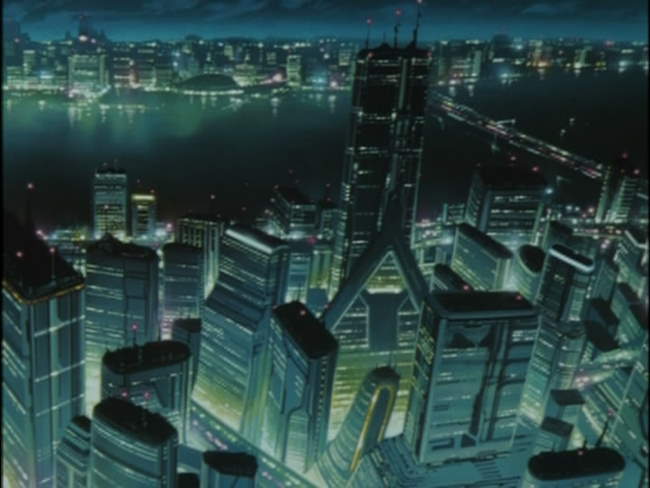
The Stories: There are three separate, interlinked stories on the Parasite Dolls OVA. At the start of the first story, set in the year 2034, where society has become a troubled mix of humans and androids called “Boomers.” The Genom Cooperation has created boomers to serve mankind in all aspects, from police support to sex dolls. Unfortunately, problems emerge, both with the boomers and with humanity’s reaction to their presence. A clandestine division of the Advanced Police (A.D Police) called “Branch” has been created to investigate human to boomer related crimes. The story follows “Buzz” Nikvest, a policeman with a troubled past, and his partners at the Branch division, which include a very helpful Boomer called Kimball and a stereotyped spunky, sexy, tough cop chick named Reiko Michaelson.
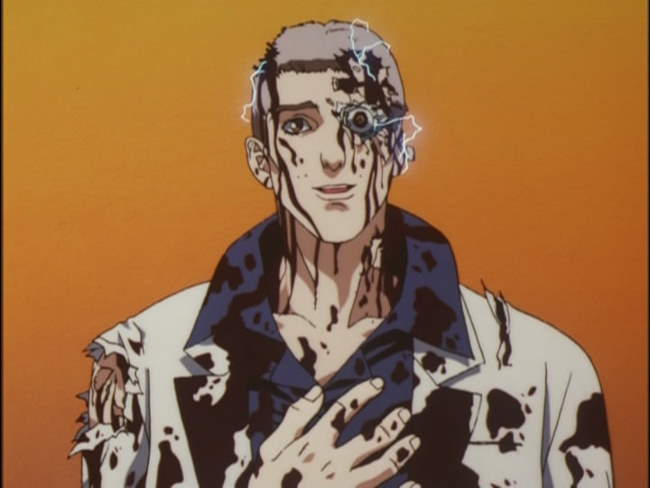
In the first episode, rogue boomers start randomly attacking and killing innocent humans. Buzz and company are brought in to investigate. During the course of their investigation, they find that things at the Genom corporation are not all above board. This story has some pretty cool visuals of shot-up boomers, and a few interesting
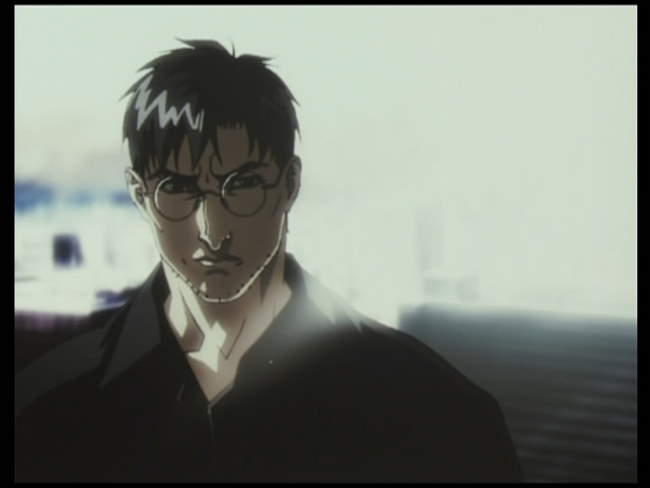
The second episode, which takes place a year later, involves a truly bizarre android monster called the “Boomer Crusher” and a very lifelike boomer prostitute who has feelings and has dreams. Unfortunately, the prostitute is being controlled in her dreams to cause some truly bizarre human deaths. We find out more in the third story of who probably created this monster, but it isn’t really stated in the narrative.
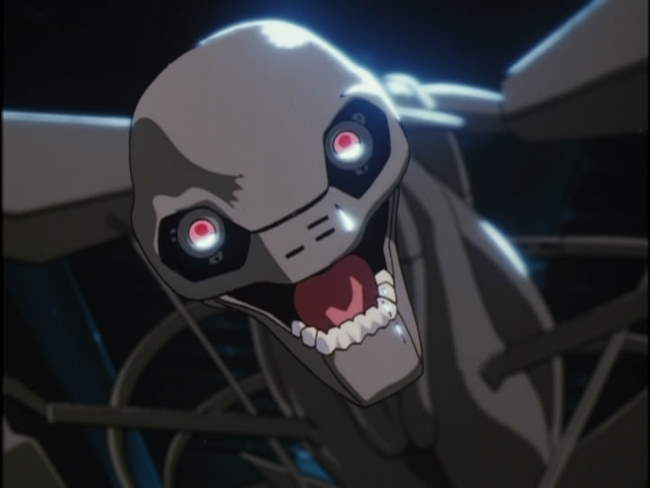
In the third episode, which takes place 5 years later, Takahashi, the head of Branch Division is missing. In searching for their missing box, Buzz, Kimball and Reiko find a connection between Takahashi’s disappearance and the recent spate of anti-boomer activity that has grown in recent years. Worse, as explosions go off all over the city, Buzz is framed as the fall guy. As the story unfolds, the viewer is left with the idea that all three stories are related to the same larger plot.
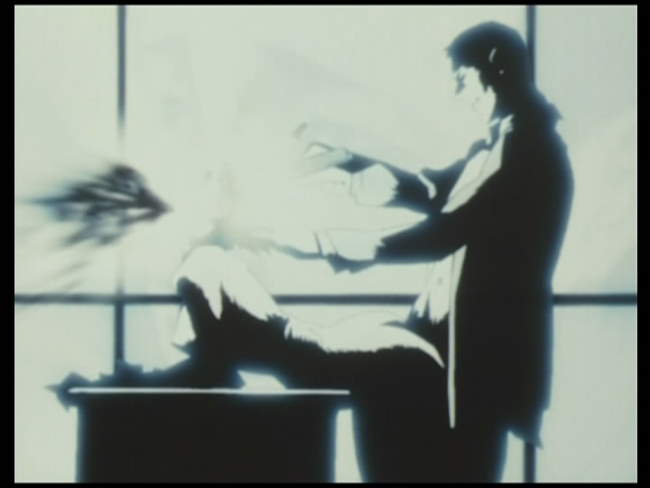
The Visuals: Parasite Dolls has a really nice diversity of looks, often emphasizing extreme shadows in single color light settings. Both blue and gray are used extensively for this, often yielding terrific visuals. In other cases, Parasite Dolls looks like a rather decent, but not spectacular anime. It does best when it strives for the edgy look. Had this been used throughout, Parasite Dolls could have come off as something bordering on special. As it stands, some parts really stand out, while others you almost wait to get through.
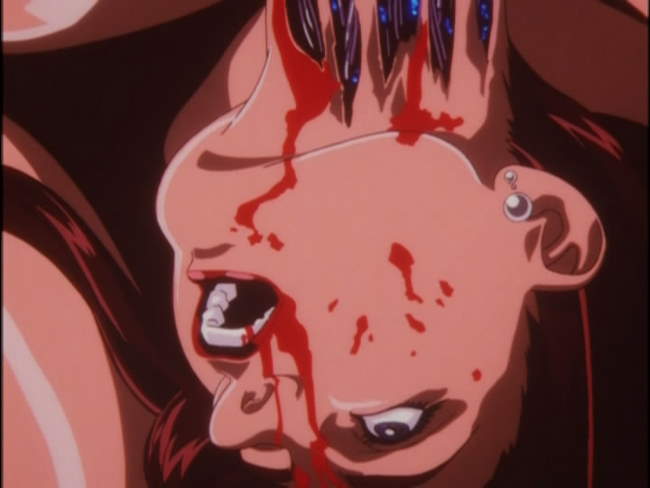
Boomers – property or unique individuals: Nothing new here – Parasite Dolls explores the continually explored question of whether androids are merely property or something more unique. Unfortunately, no new ground is traversed. Instead, the interesting aspects of this come from the seedy visuals themselves. There are a few scenes in Parasite Dolls where the visuals make a far more interesting statement than the narrative. These usually involve truly gruesome Boomer deaths.
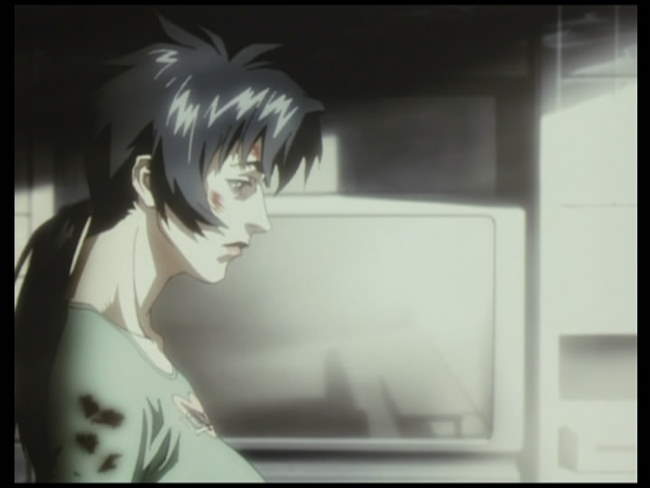
The Seedy Underground: A seedy feeling pervades Parasite Dolls. We get nudie bars, slovenly side-walks, seedy corporate meetings, and absolutely base human behavior. We have hot chick boomers continually debased and abused. Even the weird creatures that appear have an icky feel to them. The constant theme we see here are fallen boomers. They had so much potential, but…
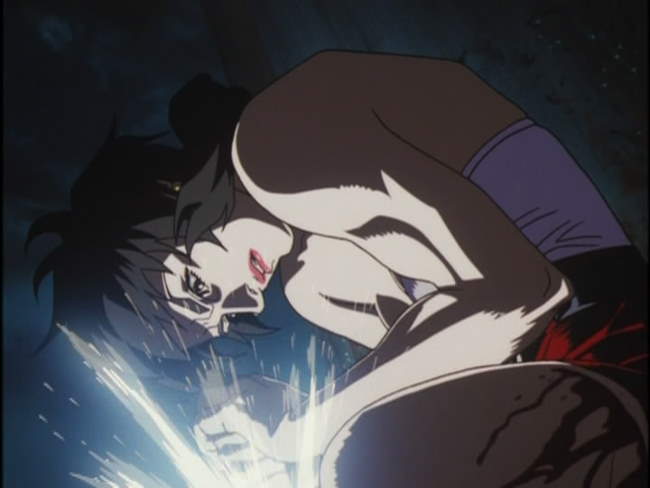
The Bottom Line: The stories themselves are somewhat uneven and problematic, but the visuals are interesting enough to make this worth a watch. While the narrative is more straight forward than many of Chiaki Konaka’s stories, it does require a few minutes thought to put the overall picture together – otherwise, all three episodes almost seem disconnection. Even though Buzz is a pretty interesting character, the rest of the characters we encounter are pretty much the cookie-cutter variety. Worse, as the episodes take place over a six-year time period, you would really expect to see growth in the characters, or at least changes in the nature of their relationships. Instead, the characters we encounter at the beginning are the same ones six years later. Still, for a 3 part OVA, Parasite Dolls is worth a watch for the visuals alone.
~See movies similar to this one~
Movie Review By: SFAM
Year: 2004
Directed by: Shinji Aramaki
Written by: Masamune Shirow (Manga), Haruka Handa & Tsutomu Kamishiro (screenplay)
IMDB Reference
Degree of Cyberpunk Visuals: Very High
Correlation to Cyberpunk Themes: Medium
Key Cast Members:
Deunan Knute: Ai Kobayashi
Briareos: Jûrôta Kosugi
Hitomi: Yuki Matsuoka
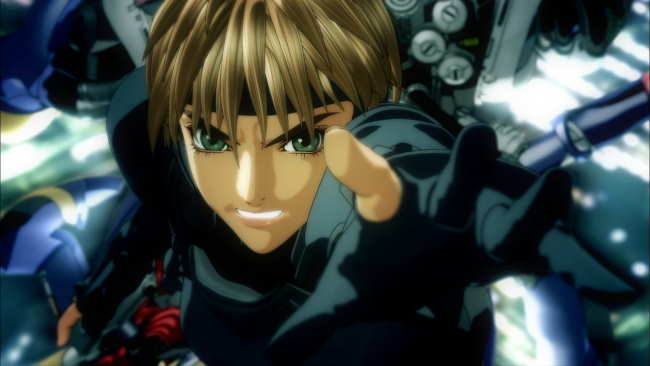
Overview: Masamune Shirow’s Appleseed recently got a second anime treatment. The last was in 1988 – this time, in 2004, the anime is done up in eye-popping 3D graphics. With a budget of only 10 million as compared to over 90 million for a movie like The Incredibles, we shouldn’t be expecting too much. Surprisingly, we get far more than expected, especially with regards to the wonderfuly rendered backgrounds. While the animation is interesting enough, the story is more problematic. So too are the change in the feel of the characters. This is really where the original version succeeds far better than Aramaki’s version.
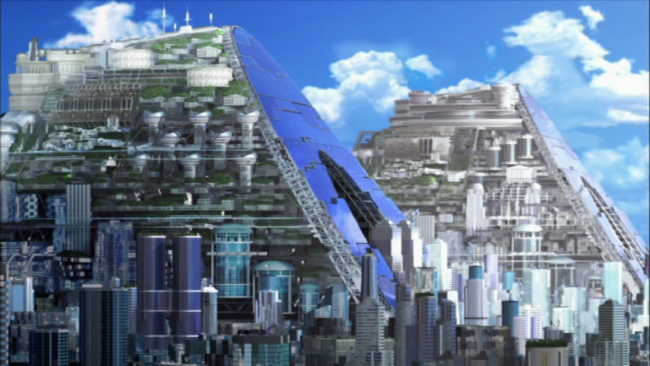
The Story: Appleseed takes place in the year 2131, a war-ravaged dystopian future where most all of human society is in ruins. Over two years after the last war, the only example of advanced human civilization is a newly made city called Olympia, which has been engineered to be a created as a perfect refuge from the rest of the world. Over half of the city’s inhabitants are comprised of bio-engineered “biodroids,” which are human-like beings designed to serve specific roles in the society. An all-knowing computer named GIA supports the city council in controlling all aspects of city life.
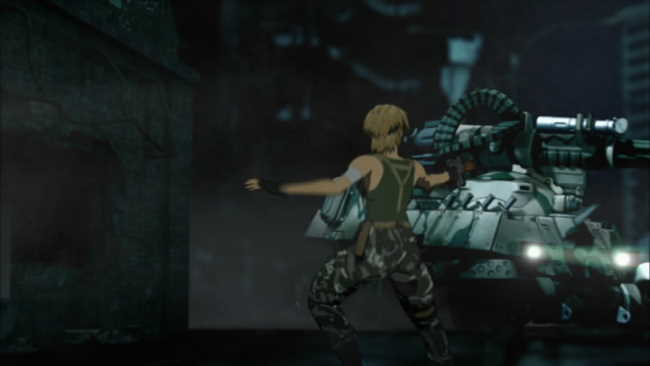
Deunan Knute, a fighter extraordinaire has been living alone in the wastelands, not realizing that the war is over. She is beset by two warring groups of fighters, one of which who is trying to kill her, and the other group, which rescues her and takes her to Olympia. There she is re-acquainted with her long lost lover, Briareos, who now has been transformed into a cyborg after his body was lost in the war. She is tasked to join “ESWAT,” a special mecha-enabled police force that keeps order within the city. Deunan also befriends a biodroid named Hitomi, who shows her around the city. Unfortunately, Deunan barely gets a chance to settle down before the assassination attempts on her life start.
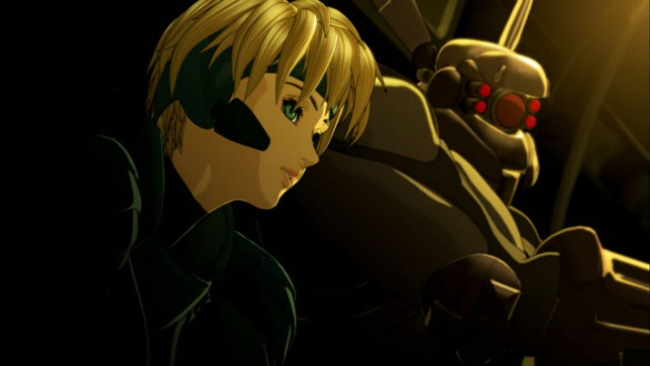
Duenan quickly learns that she has been dropped in the middle of a power struggle between humans, who are concerned that the biodroids secretly aim to exterminate them, and biodroids, who worry the same about the humans. Somehow, Deunan has become essential in this struggle, yet it has nothing to do with her fighting capabilities. It turns out that her parents, before dying, developed a method for biodroids to reproduce, which would make them almost exactly like humans. But this research was lost long ago. Now, Deunan has become a pawn for both sides of this struggle, and worse, it appears as if her ex-lover, Briareos has chosen sides.

Unfortunately, the story in this version of Appleseed is problematic at best. There are too many sub-plots that obfuscate the key points. The myriad of loose ends introduced that are never followed up on. Gia, the sentient computer that runs Olympus is the probably the worst casualty. We get introduced to her, and, if you know something of the Appleseed story from the Manga, you expect to see lots more than what actually ends up being conveyed. In the end, the plot centers on a simple theme of racism. This is a shame as there were so many interesting cyberpunk aspects of Olympus that get short-circuited.
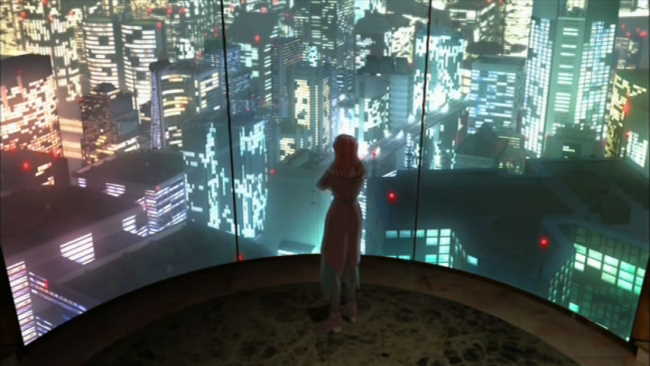
The Animation: Appleseed’s backgrounds are wonderfully rendered. This more than anything accounts for the majority of the “wows” Appleseed received. They are done in a way that allows 3D camera maneuvering, so as to allow you to see the same scene from multiple angles, and at times, even provides Matrix bullet-time effects. For the most part, the 3D CG overlaid with 2D cell shading really works. It’s an extension of the idea we saw in Malice@Doll, only with far better rendering tools. The machines look especially awesome. Both the Gunhed style tanks at the beginning of the movie and the platform sentinels at the end. Unlike many cyberpunk movies, there isn’t a dominating color palette in Appleseed, but the color scheme seems to stick more often than not to light and dark shades blue-greens, with yellow & browns in transition scenes.
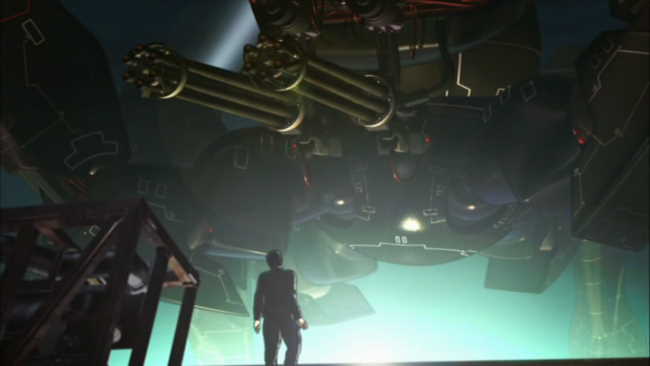
In terms of the characters, only Deunan Knute really looks polished. Her body movements, facial expressions and general actions really work. The rest, especially the human characters, often look stilted in their moments. Hitomi, their biodroid friend, is especially problematic at times. This might be due more to the motion-capture techniques they use, which work wonderfully for the city, but not so well for the characters. Also, I really dislike the way they animated the hair. The hair on the humans in the 2004 edition look like something out of Reboot. However, considering the budget, I think they made the right decision in spending scarce resources on Deunan. Had they just made everyone look slightly better, Appleseed would have faltered horribly. By at least making Deunan polished, they developed a star that fit right alongside their wonderful backgrounds.
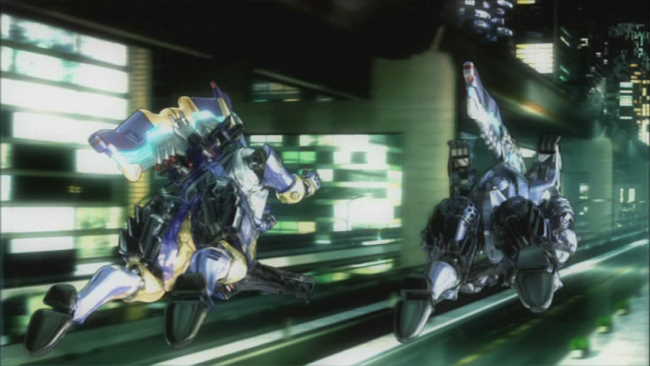
The Sound: Many times throughout the anime, Appleseed plays more like a music video than it does a movie. The modern heavy rock beats worked well for the action scenes. And truly, the action scenes are where Appleseed excels. There, the 3D positional sound, the music accompaniment and the 3D CG graphics are at their absolute best. The accompanying score really wasn’t all the memorable, but at least served up the slower paced moods fairly well.
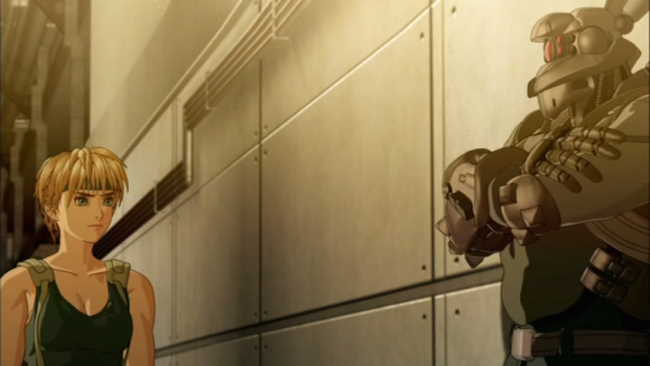
Differences From Shirow’s Work: While both animes deviate from Masamune Shirow’s Appleseed Manga, Aramaki’s version is the most egregious. While the 2004 version starts outside of Olympia as the Manga does, it only has Duenan there, whereas in the Manga has both. This version introduces a new dramatic twist of Duenan and Briareos getting back together for the first time in two years. While this in itself isn’t bad, the side-effect is: these two characters are no NOTHING like the Manga. The Duenan Knute and Briareos of Shirow’s Manga, and of the 1988 version, are precursors to the Ghost in the Shell’s Motoko and Batou. Here, Briareos is a moody, lost soul trying to deal with his cyborg body, and Duenan is far more vulnerable than tough. The playful chemistry we see between these two both in the Manga and the 1988 anime is completely missing here. For those who aren’t familiar with the Manga, this probably won’t bug you, but it certainly sapped some of the enjoyment out of this movie for me – so much so that I’m dropping a star off the review for it.
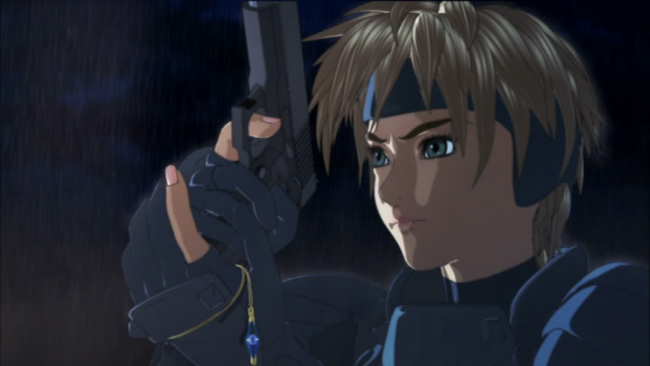
The Bottom Line: Appleseed is definitely worth seeing for the visuals alone. While some of the characters don’t work, the Duenan, the machines and the action scenes work wonderfully. Unfortunately, the story doesn’t equal up. Too many elements are introduced and then discarded in favor of a truly simplistic storyline. They could have done better. Also, as I mention above, this is not the Deunan and Briareos I’ve become familiar with – these characters are different from both the Manga and the earlier anime. This bugged me enough to drop a star from the review, but you might not mind so much.
Page 2: More Screencaps –>>
~See movies similar to this one~
Movie Review By: SFAM
Year: 1981
Directed by: Gerald Potterton, Jimmy T. Murakami
Written by: Len Blum et al.
IMDB Reference
Degree of Cyberpunk Visuals: Medium
Correlation to Cyberpunk Themes: Low
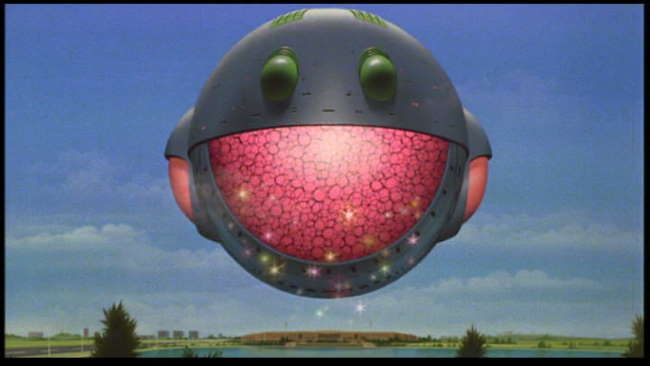
Overview: Heavy Metal represents one of my great teenage film memories. Back in the day, before the porn repository known as the internet was formed, Heavy Metal was edgy stuff. As a young teen, Heavy Metal was everything a kid my age wanted to see – sex, drugs, rock-n-roll, violence, defiance of authority, and hot chicks! Add the most awesome hard rock soundtrack, and Heavy Metal became the drug of choice for young folk back then. That it was animated somehow made it alright with the parents. Make no mistake – Heavy Metal is not high brow fare, nor is it particularly well made. But it is definitely a very fun guilty pleasure.
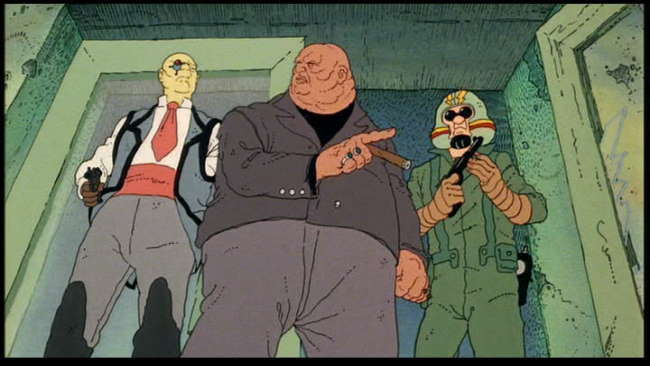
The Story: Heavy Metal is a series of somewhat interrelated vignettes about the journey that ultimate evil makes, this time in form of an evil sentient green orb, called the Loch-Nar. The Loch-Nar captures a little girl in present times for reasons unknown till the end, and shows her a series of stories about how the Orb has corrupted people of all races in all times and places.
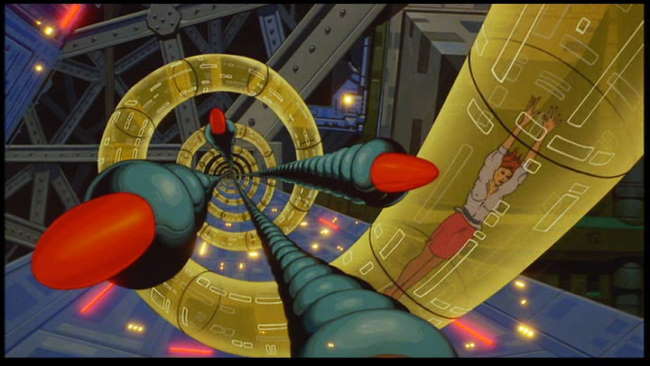
In each story segment, we get a strange, otherwordly setting in which the orb enters, corrupts and then leaves. Often a hero stops the orb from fully corrupting everything, but always the orb leaves a stain. The atmosphere is one of interrupting and ongoing scene with something truly unusual that occurs. But it’s the ending vignette, Taarna which is the best, and also the one that finally gives us insight into why the Loch-Nar has captured this little girl. Taarna isn’t really cyberpunk in any way but a few of the visuals, but it is a lot of fun.

Is it cyberpunk? Clearly, some of the vignettes, many in fact, are more fantasy than cyberpunk. So why do I have this movie listed? While some of the vignettes do have the cyberpunk feel, most clearly Harry Canyon, Heavy Metal absolutely belongs here due to its magazine roots. Both William Gibson and Ridley Scott credit visuals in the Heavy Metal Magazine is very influential for helping create their settings. Most cited is the Moebuis illustrated “The Long Tomorrow” comic. As you can see by the link, the Long tomorrow gives us a gritty neo-noir, near future comic that’s edgy, dangerous, and lots of fun. And more importantly, the atmosphere – the mood in Heavy Metal throughout seems pretty cyberpunk.
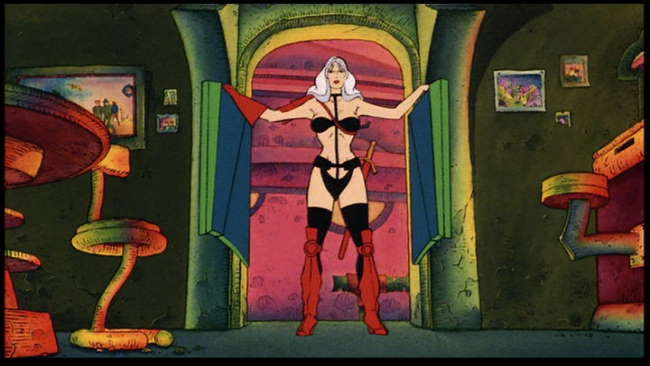
Heavy Metal is Male Fantasy Material: Heavy Metal is NOT sophisticated - far from it in fact. Heavy Metal caters to the sophomoric, prepubescent male, and emphasizes gratuitous nudity, hot chicks kicking butt, nerds who grow massive bodies and get laid, android-hot chick sex, etc. Heavy Metal falls right in line with the old “Gonad the Barbarian” style books, so in this way, it really isn’t cyberpunk. Cyberpunk as a sub-genre dramatically improved the quality and intelligence of what we found on the scifi-fantasy shelves. Heavy Metal the movie does not, although many of the stories do provoke an interesting thought or two.
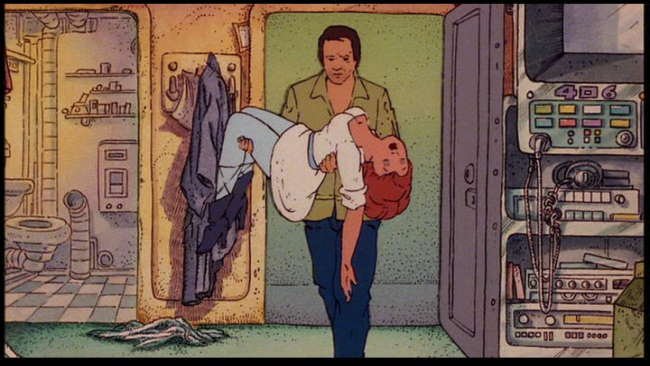
The Animation: Each story segment is written and animated by completely different teams, although some of the voice actors such as John Candy appear in many episodes. Some of the segments seem pretty simple, whereas others have more than decent texture. All in all, Heavy Metal represents a mixed bag, but at the time, it truly was on the revolutionary side. While French director René Laloux’s most awesome animated movies were far better, outside of them, few things touched Heavy Metal. The fact that Heavy Metal included the themes and visuals teens were looking for back then transformed it into the ultimate cult rebellion flick.
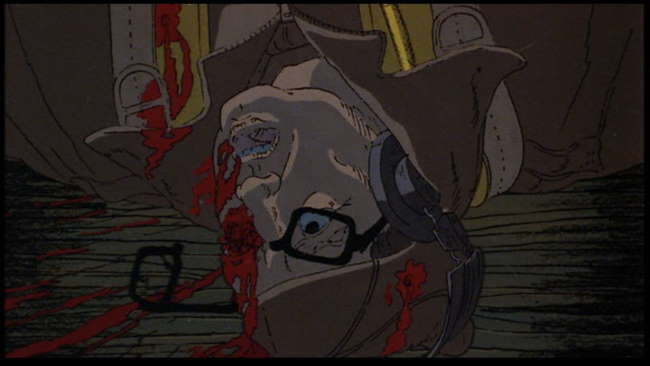
The Sound Track: Heavy Metal still should be considered among the best sound tracks for a movie. It SOOO added to the atmosphere. We get a heaping dose of great hard rock from the likes of Blue Oyster Cult, Black Sabbath, Sammy Hagar, Cheap Trick, and Don Felder’s most awesome rendition of Heavy Metal (Takin’ A Ride). In addition, we get great little 80s tunes like Devo’s “Working in a Coal Mine,” Journey’s “Open Arms,” and Stevie Nicks’ “Blue Lamp.” Truly, if you’re interested in experiencing 80s counter-culture at its fantasized finest, Heavy Metal is the movie to watch.
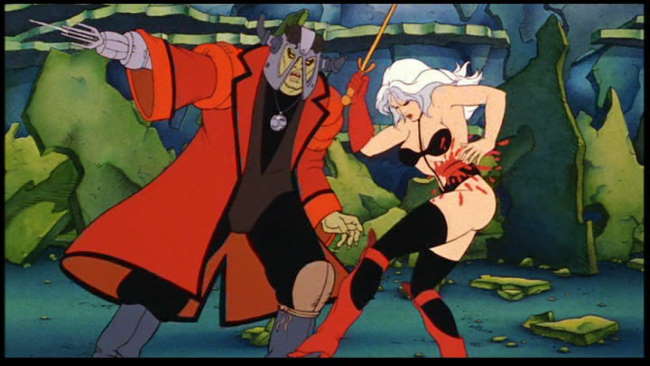
The Bottom Line: Heavy Metal is not a great movie, but it is a lot of fun. While it has a few vignettes that are clearly cyberpunk in nature, the majority of the movie is unsophisticated SciFi-Fantasy. Still, the visuals and atmosphere are more than interesting, as are the diversity of animation styles. Heavy Metal should be seen more for the vision this film represents from the Magazine. This, as much as anything is responsible for the genre we now call cyberpunk.
~See movies similar to this one~
Movie Review By: SFAM
Year: 1993
Directed by: Sumiyoshi Furakawa
Written by: Yasushi Hirano (story), Kazumasa Hirai & Jirô Kuwata (characters)
IMDB Reference
Degree of Cyberpunk Visuals: Low
Correlation to Cyberpunk Themes: High
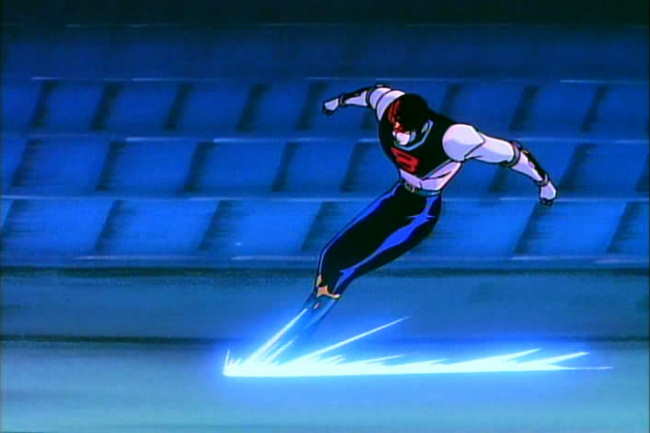
Overview: If you’re hankering for a sequel to Robocop, skip the live action sequels, and instead get 8 Man After. You won’t get the best animation, but the story itself is more than passable. The characters aren’t all that deep, but they’re interesting enough to keep your attention. This OVA, which on the DVD is presented as a film, seems to rise above the obviously meager animation budget to produce a decent product.
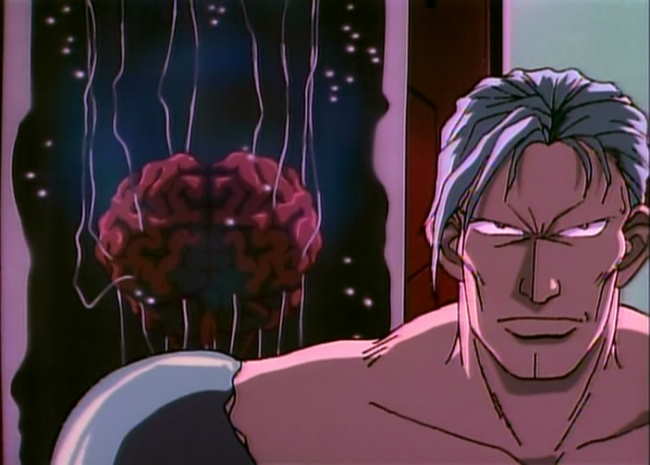
The Story: 8 Man After is a sequel to the 1960s TV series called 8th Man (I have not seen the original). In 8th Man, a cop dies, is revived, and is given a cybernetic body that can move lightning fast. He uses it to confront a cyborgs crime lord in similar circumstances, but is later killed. His girlfriend, Sachiko Yokogawa, never learns what happens to him. Since then, petty criminals with cybernetic implants have started to rule the streets. The police are outgunned, and decide they need a special edge – so they decide to revive the 8 Man.
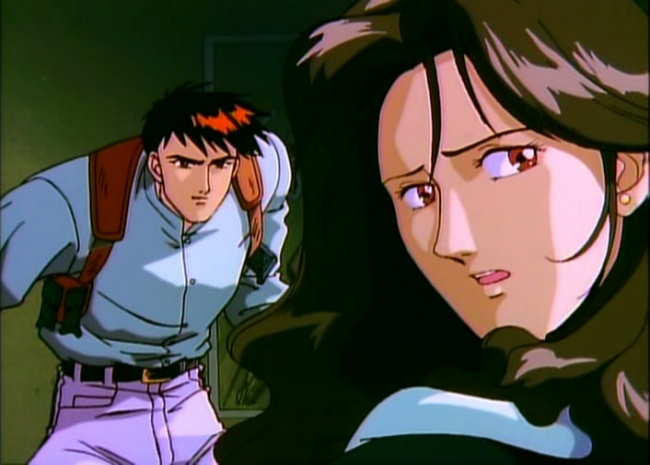
In 8 Man After, a similar situation occurs as in the original – this time, police detective Hazama Itsuro, an emotionally fragile cop, meets up with Sachiko on a chance encounter, and they begin to fall in love. But fate intervenes, and a nasty criminal with cyborgs implants comes to kill them. Hazama is able to defeat him, but seemingly dies in the process by falling out of a high story window. Hazama is revived when the police take Hazama’s brain and insert it into 8 Man’s body.
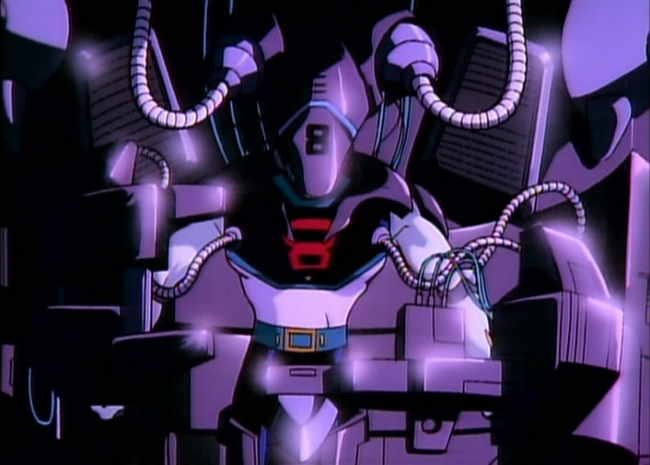
Hazama can now move lightning fast, and due to technical reasons, is the most advanced cyborgs on earth. He begins to fight the bad guys, but unfortunately, it turns out that his emotional troubles cause him to occasionally lose control over his actions. This is complicated by Hazama’s continuing relationship with Sachiko, who does not know what he’s become. Things come to a head when Hazama/8 Man goes up against the crime lord while trying to rescue Sachiko.
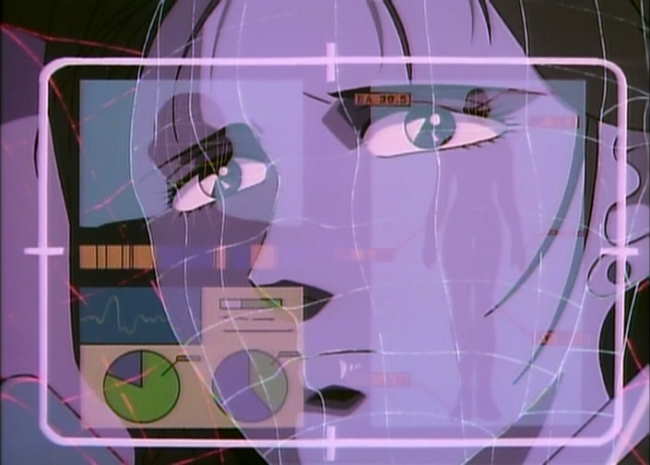
This is a “Who am I?” Story: 8 Man After does a decent job of going over established ground in that it questions whether a brain inserted into a cyborgs host is still human. The complicating twist in 8 Man’s case is that his emotions end up making him temporarily lose control over his body, and in fact, lose awareness over certain events. The added relationship aspect, where Sachiko has now fallen in love with two people who end up losing their bodies is sort of interesting as well. Again, there’s nothing really new here, but it is well done.
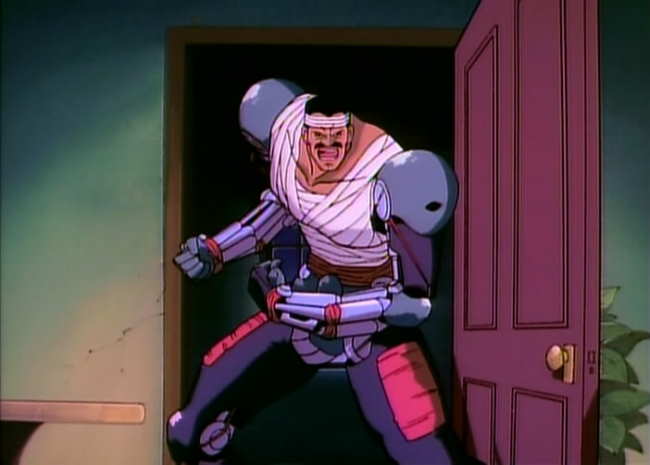
The Animation: At some level, animation of this quality, five years after Akira is surprising. Many of the shots look like straight Saturday morning cartoon fodder. Every now and then, we get a terrific shot or two, and sometimes get an innovating looking camera approach, but for the most part, you get simplistic backgrounds, very basic character designs, linear movement, and lots of pan and scans of stills. Worse, you also get some repeated 8 Man after streaking shots. Without an absolutely kickin story (which it has), 8 Man After just wouldn’t be worth the time.
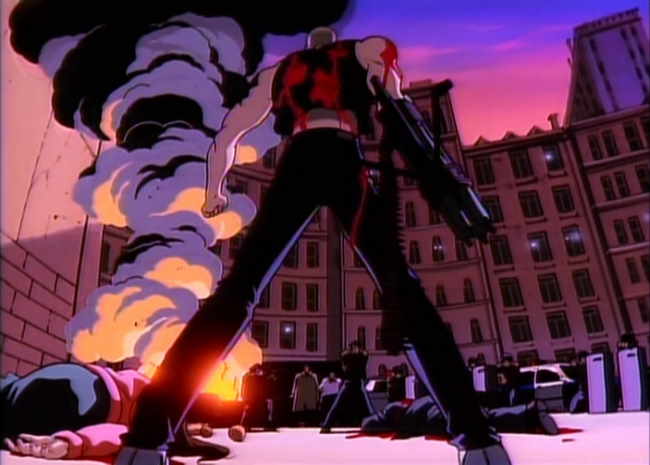
The Violence: Like Robocop, 8 Man After is very violent. However, the animation isn’t good enough for this to really matter all that much. There is lots of blood and killing which is usually don’t in the context of a motivating story, but it just doesn’t have the impact of many violent animes. Even if you can’t stomach violent story lines, you will probably be OK with 8 Man After.
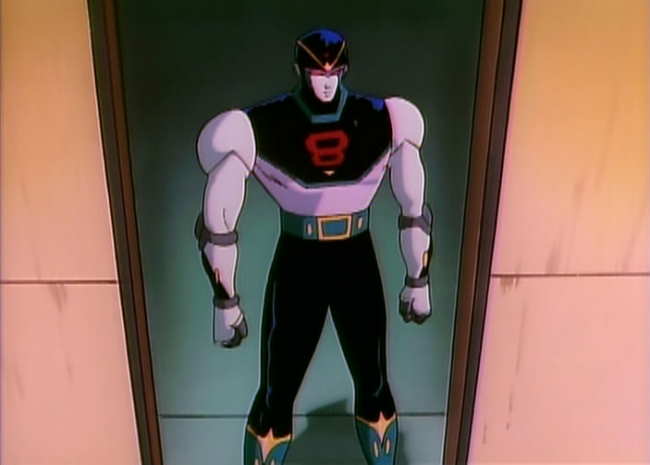
The Bottom Line: OK, the animation isn’t the greatest, but the story is pretty good – FAR better than the Robocop sequels. The sub-plot of the son with a burnt-out cyborg father is especially well done. If you’re looking for a Robocop-like examination of humanity, animated from the cyborg’s perspective, 8 Man After is a decent choice.
~See movies similar to this one~
Movie Review By: SFAM
Year: 1995
Directed by: Peter Chung & Howard Baker
Written by: Peter Chung et. al.
IMDB Reference
Degree of Cyberpunk Visuals: Very High
Correlation to Cyberpunk Themes: High
Key Cast Members:
Æon Flux: Denise Poirier (voice)
Trevor Goodchild: John Rafter Lee (voice)
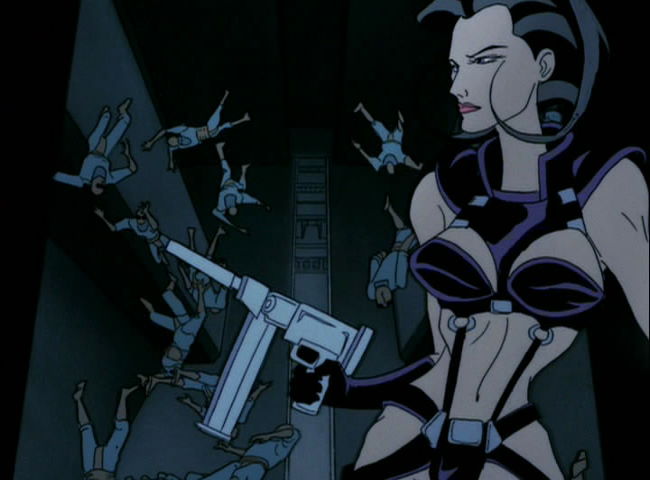
Overview: Aeon-Flux, the brainchild of Peter Chung (also the writer/director of the terrific Animatrix short, “Matriculated”), is one of the really innovative and unique animated shows to come out of the United States. We really have to thank MTV for allowing this show to get produced, and then, after realizing that they just couldn’t control it, for letting it go on unfettered for a second season. Aeon-Flux is not meant to be a coherent whole – this postmodern cyberpunk show is as nihilistic as they come.
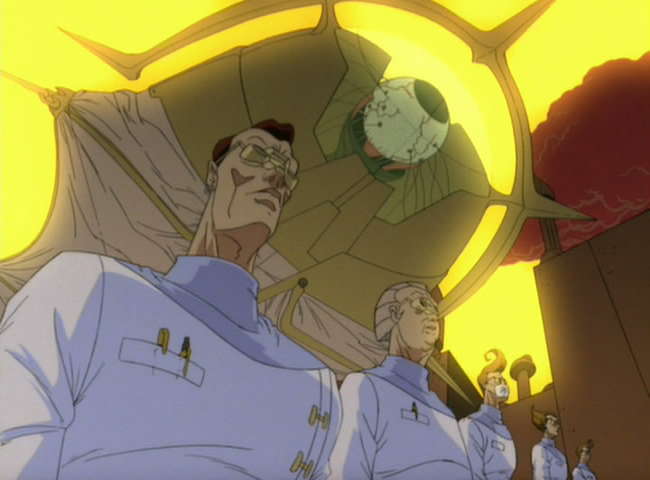
The Story: Aeon Flux takes place in a truly bizarre near-future setting, in which genetic engineering, body modifications, and excessive self-gratification are the norm – yet these extremes take place in a controlled surveillance society. Nearly all events take place in the utopian city, Bregna, which is controlled by a supreme oligarchy. Trevor (voiced by Vampire Hunter D’s John Rafter Lee), one of the two central characters, is a prototypical mad scientist who, at first seems to have little regard for anything other than his own perverted desires. As the show goes on, we find that he is in fact truly besotted with Aeon Flux, who, in many ways is his complete opposite. Aeon Flux (voiced by Denise Poirier) represents the forces of anarchy, and is continually involved in fucking up Trevor’s carefully laid scheming. Unfortunately for Aeon, she too cannot resist Trevor’s guile, which just as often, leads to her downfall.
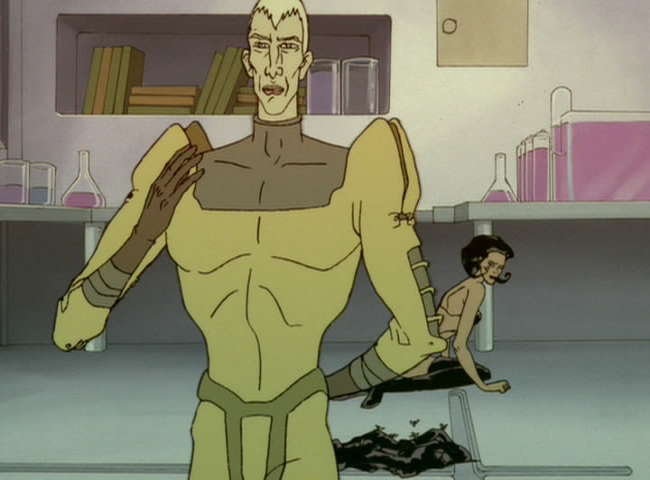
Virtually every episode is different in Aeon Flux, but all of them deal with a strange, fast-paced plot that deals with espionage in some way. Episodes usually have the feel of a chess match, where Aeon and Trevor match wits over completely strange and esoteric plots. More often than not, nobody wins. In fact, unlike most shows, the winning and ending itself is rarely important. This is not what the shows are about. More important is the mood, the feel, and the atmosphere that exudes from the visuals, the dialogue and the score.
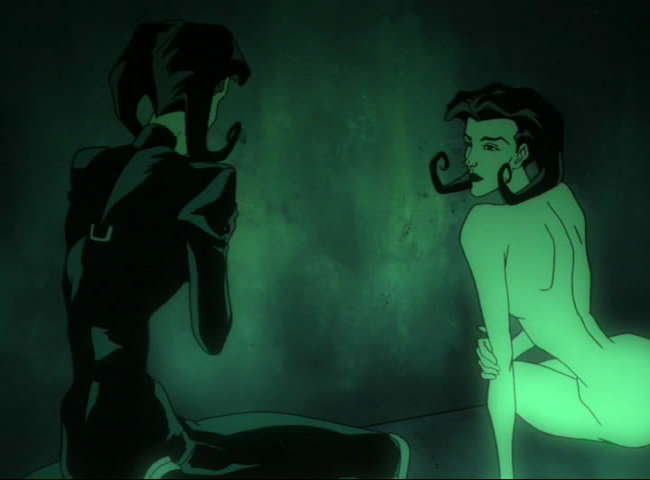
Spoiler – Aeon Flux Dies…A lot! Well, OK, it’s not really a spoiler. It’s more a fact of the show itself. Unlike most shows, in this one, the star dies regularly. Early on in the long shows, Trevor clones Aeon Flux, so thematically, there is now an infinite number of Aeons just waiting to bite the big one. And while there’s now a “rationale” for the deaths, this isn’t really the point – Aeon Flux isn’t meant to hold together that way. It’s almost as if each episode is completely it’s own show. But if she dies, rest assured it will happen in a truly innovative and gruesome way. It could be drowning in a vat of poisen, getting dropped out of a plane, being eating by bizarre genetically modified creatures, or, well, you get the idea. .
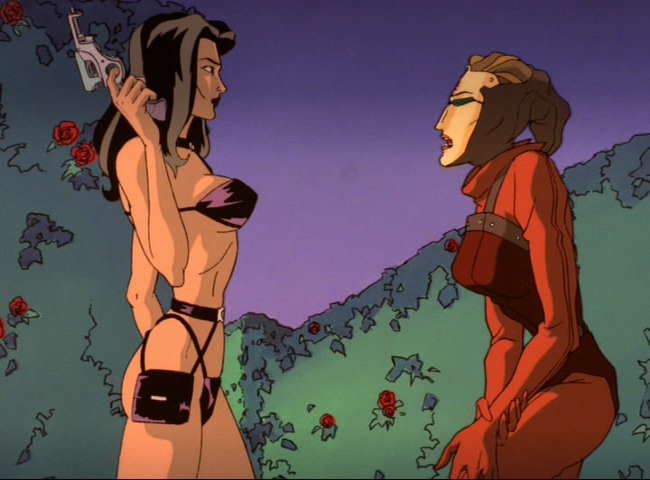
Aeon Flux – the Ultimate Anti-heroine? In many ways, Aeon Flux comes across as the ultimate anti-heroine. While she clearly knows right from wrong, and generally tries to stop the worst abuses, Aeon is an ultra-acrobatic, top-notch action/espionage heroine who works for herself. She’s just as likely to take an assassination job as she is to stop a horrid virus from killing mankind. Did I mention she’s drawn up in ultra-hot, skimpy clothes, and likes to have sex a lot? In this way, she really does qualify as a more female than female character (usually cyberpunk reserves these for cyborgs and androids). Most interestingly, because of Aeon Flux’s propensity for dying, you never know whether or not she’s going to make it through alive, or even whether she’ll complete her mission (she seems to fail almost as much as she succeeds). This really does add an excitement to the episodes.
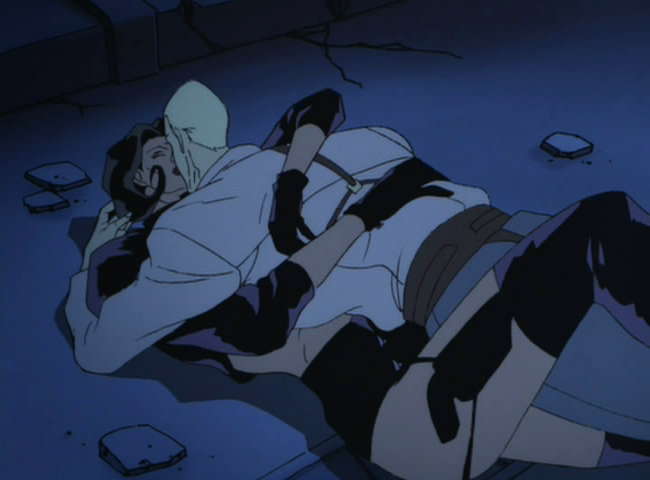
The Love-Hate Relationship: Aeon-Flux and Trevor have a complete love-hate relationship. Even when they are bent on killing one-another, there is always sexual tension, which while often consummated, never leaves the two characters. Every episode gives us yet another chance to explore their relationship in a completely bizarre way. Trevor is definitely Aeon’s Kryptonite. More often than not, his presence alone is enough to make her botch her mission. However, this doesn’t stop Aeon from ruining most, if not all of Trevor’s take over the world plots.
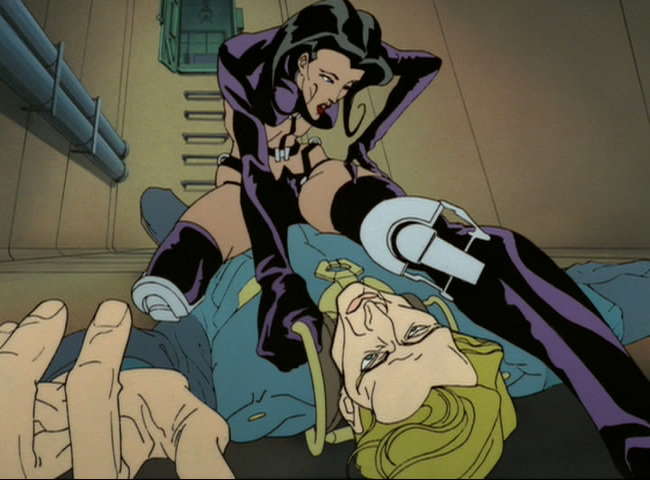
The Visuals and Cinematography: Aeon Flux gives a number of different looks as the show progresses. Perhaps my favorite are the perspective shots such as the one above. We also get lots of wide angle shots, strange close-ups, gradients, and a number of truly surrealistic sets. Unlike most cyberpunk, Aeon Flux doesn’t really adhere to a single dominating color scheme – but to the extent it does, the blues are more highlighted than the rest. Usually, each episode will have a unique theme that dictates the color choices – often they will take a color palette (oranges, greens, etc.) and detail it out in interesting ways. Some episodes are truly surreal in nature, while others are straight neo-noir. The overall goal is always to innovatively create a far-out intense atmosphere wrapped up in a tightly paced, no-nonsense near-future espionage show. More often than not it succeeds.
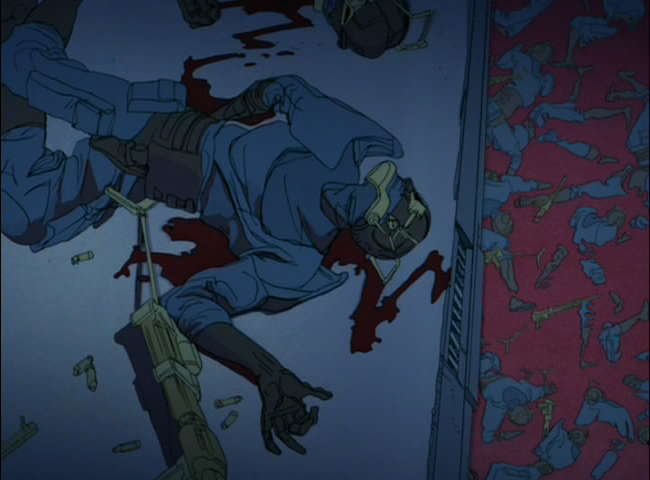
The Violence: Much to MTV’s initial chagrin, Aeon Flux is NOT a kids show. This is an adult cartoon in every way possible, including the intense violence. While the shorts are more violent than the half-hour episodes, Aeon Flux is consistently violent. There are leg amputations, deaths by gunshot, poison, insects, creatures, aliens, viruses, et cetera (often to Aeon herself!). Blood and gore are often just a scene or two away. All of this serves to strengthen the near-future but otherworldly atmosphere of Aeon Flux.
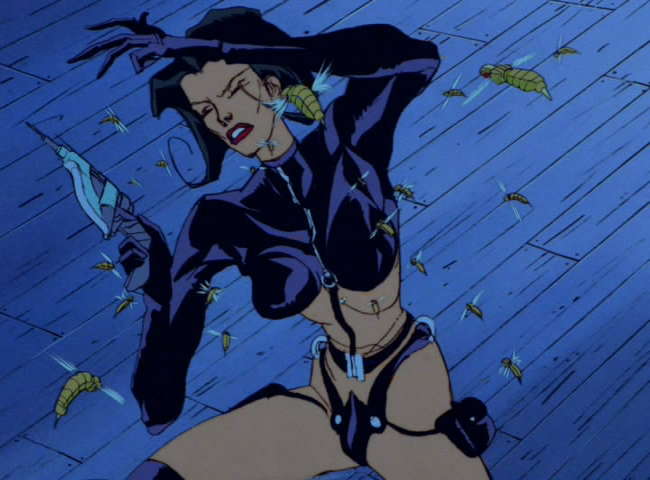
The Gadgets: Aeon-Flux is filled with gadgets of all flavors. Most common are body modifications and “biopunk” elements (just learned that word ). Body modifications include external spinal cord implants, leg jumping implants, conversions of limbs, eye implants, and various compartmentalized bodily storage areas. Genetic engineering is a huge theme in Aeon Flux, far more than the cyber-aspects. We also see repeated instances of cybernetically modified insects who’s function is to inflict a virus of some kind into a target population (Now we know where DARPA got the idea from!). Needles are also a recurring them, and show up everywhere from guns, to security implements, to, um, the operating table.
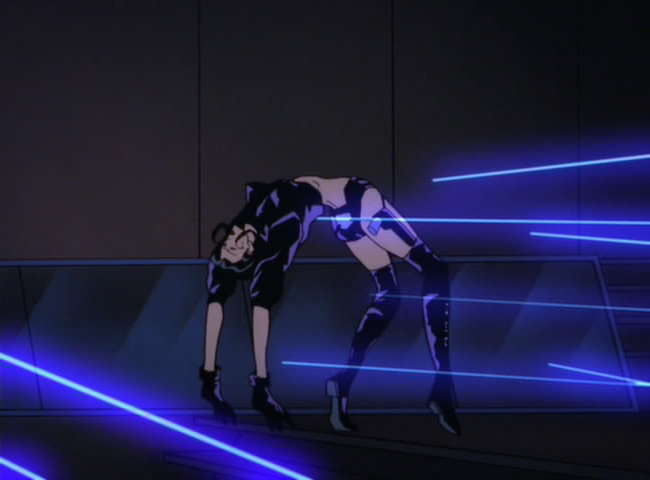
The Bottom Line: Aeon Flux is one of the really creative shows to come out of United States Television. This show validates the purpose of cable TV – we get to see talented folks like Peter Chung let lose their creative energies to produce something truly unique. And while I normally don’t spend too much time talking about the DVD features, I must on Aeon-Flux – the DVD set is flat-out terrific. I almost put it up there with Errol Flynn’s Robin Hood and The Kino edition of Metropolis as one of my favorite DVD productions of a long-lost show. The commentaries, featurettes, and extras are all terrific on the Aeon Flux DVD. If I had any qualms about whether to give Aeon Flux 8 or 9 stars, the incredible quality of the DVD set answers it for me.
More Aeon Flux Screencaps on Page 2–>>
~See movies similar to this one~
|








































































































